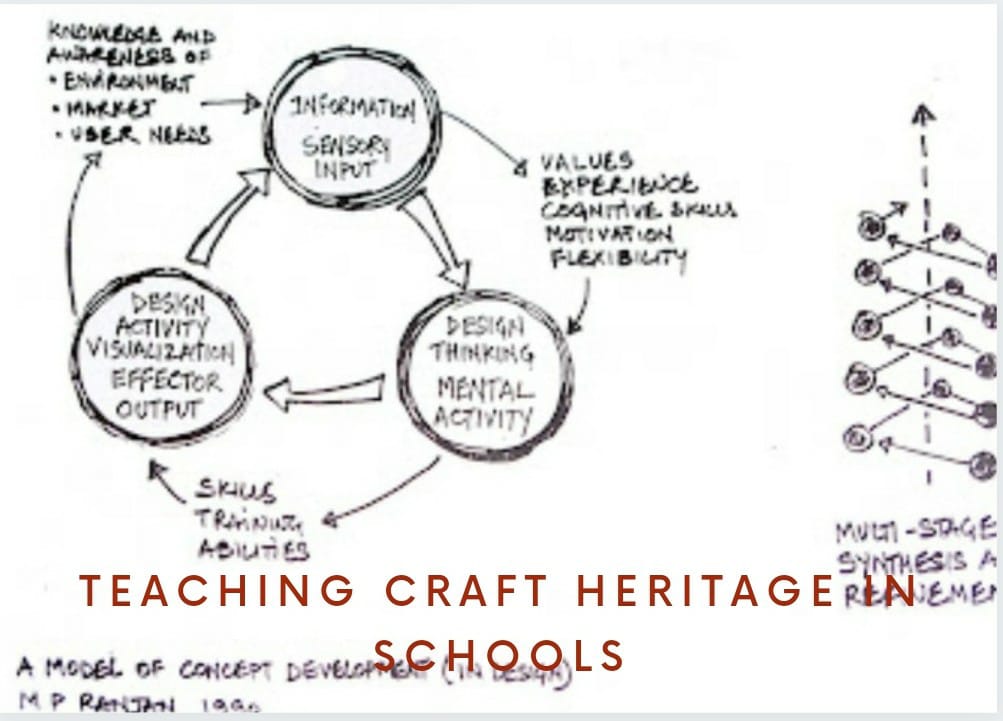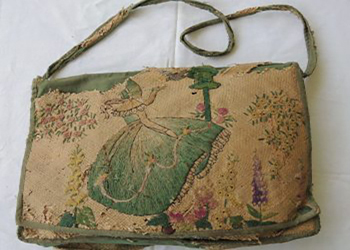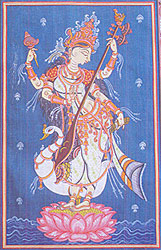JOURNAL ARCHIVE
Issue #002, Winter, 2019 ISSN: 2581- 9410
|
In this context of globalization and growing extension of modern communication techniques, there is paradoxically a quest for quality, identity and originality. While countries, individuals and groups are more and more committed to combining the ability to participate in the world of technology and open markets with the promotion of their cultural heritage, it is not surprising therefore that tourism has moved from the 3 S (sun, sea and sex) to the 3 E (entertainment, excitement and education). How then can we make the best of this favorable wind of change to further promote crafts development? - Address by Mr. Indrasen Vencatachellum, UNESCO Representative, at the Closing Ceremony of the International Workshop on Tourism and Crafts. Tourism is the largest industry in the world and directly employs about 36 million of India’s people. Although the effects of tourism on the craft industry have yet to be thoroughly studied, the 6.8 millions tourists that visit South Asia every year clearly provide India’s artisans with opportunities for sales and direct market feedback. In reports from the Asian Development Bank, experts forecast that tourists into South Asia will reach at least 18.8 million visitors by 2020, which will undoubtedly bring billions of dollars into the region. However, all is not positive. The tourism industry has had to deal with the threefold blow of 9/11, SARS (and now the Avian Flu) and the war in Iraq. These factors made 2003 the worst year on record for global tourism, with a decrease of nine million worldwide tourist visits from 2002. Clearly the biggest threat to tourism is the feelings of uncertainty that travelers daily face when presented with images of bombsites and war ravaged villages and growing concern over health statistics and death tolls. India’s place in this overwhelming uncertainty is often vague. Although, India receives far more visitors than its surrounding South Asia neighbors, she still deals with an image that contains threats to safety and health as well as a location close to unstable nations with anti-western sentiments. With India’s artisans facing all these challenges in addition to their daily struggles, how can they learn to harness the power of tourism to develop their craft sectors? As with all marketing efforts the first rule it to identify the customers. The type of tourists visiting places in South Asia has not shifted much over the years with the majority of them being long-haul visitors who place value on experiences, authenticity and low prices. Of course, India also sees her fair share of short stay visitors who come with specific reason and spend much on luxury hotels, spas and goods. However, with the current global situation, even these short stay visitors are acting more spontaneously, staying much closer to home and spending less. Both type of tourists are beneficial for artisans in India, given that their specific needs can be met. Long-haul tourists are less likely to spend on goods in general since their budget is limited and their luggage small. They will spend on crafts, like textiles, that are easy to carry or ship and less expensive than other media. For example in the UNESCO Crafts/Tourism Index, UNESCO ranked the top selling craft categories to tourists in Burkina Faso as textiles, jewelry, wooden objects, bamboo and other natural fibers and leather. These categories will obviously change per country but the fact that tourists are more interested in small, easy-to-carry and less expensive items remains. Short stay tourists are, of course, more likely to spend more money in a shorter period of time and be less discerning about the size and weight of their purchases. Even though tourism overall may be struggling, the future of crafts in tourism is seeming brighter. Globalization has been often criticized as a westernization of the world, however it has created an enthusiasm about cross-cultural learning for some. Looking at trends in tourist spending and societal shifts, strong consumer excitement and awareness for sustainable tourism is predicted. In 2003 Eco-tourism accounted for about 20% of tourist spending, with the potential for growth. Eco-tourism, often described as culturally and environmentally sensitive, can include outdoor adventures as well as authentic cultural experiences in crafts villages or elsewhere. Bhutan is a prime example of a country that has placed high value on eco-tourism, not only to increase tourist spending but more importantly to preserve Bhutanese culture. For example Bhutan’s National Ecotourism Strategy states that eco-tourism is “Styles of tourism that positively enhance the conservation of the environment and/or cultural and religious heritage and respond to the needs of local communities”. Although there is much further to go in developing the tourist market, the potential that already exists is great. UNESCO’s Crafts/Tourism Index pointed out that in some cases “the direct sales to tourists of crafts items brought a larger income than exports. In Thailand, for example, tourists purchases of crafts products amount to almost 2 billion US Dollars, surpassing the total national exports.” With proper assistance and a market driven plan, crafts both in India and across the globe can harness this potential to the benefit of both the artisan and tourists as they learn more about cultures worldwide. References UNESCO Crafts/Tourim Index, Paris May 2004, Mr. Dominique Bouchart Asian Development Bank, South Asia Subregional Economic Cooperation Plan |
|
The craft or handicraft sector is the largest decentralised and unorganised sector of the Indian economy. Craftspeople form the second largest employment sector in India, second only to agriculture. Handicrafts are rightly described as the craft of the people: there are twenty-three million craftspeople in India today. In India, craft is not merely an industry but a creation symbolising the inner desire and fulfilment of the community. While handicrafts, be it metal ware, pottery, mats, wood-work or weaving, fulfil a positive need in the daily life of people, they also act as a vehicle of self-expression, and of a conscious aesthetic approach. The artisan is an important factor in the equation of Indian society and culture. By performing valid and fruitful social functions for the community, they earn for themselves a certain status and position in society. S/he is the heir to the people's traditions and weaves them into his/her craft. Most craft people have learned their skills from their fathers or mothers since caste and family affiliations, rather than training or market demand, have primacy in the Indian situation. The handicrafts sector is a home-based industry which requires minimum expenditure, infrastructure or training to set up. It uses existing skills and locally available materials. Income generation through craft does not (and this is important in a rural society) disturb the cultural and social balance of either the home or the community. Many agricultural and pastoral communities depend on their traditional craft skills as a secondary source of income in times of drought, lean harvests, floods or famine. Their skills in embroidery, weaving, basket-making are a natural means to social and financial independence. The craft sector contains many paradoxes. Artisanal contribution to the economy and the export market increases every year and more and more new crafts-people are being introduced into the sector - especially women - as a solution to rural and urban unemployment. At the same time mass-produced goods are steadily replacing utility items of daily use made by craftspeople, destroying the livelihood of many, without the concomitant capacity to absorb them into industry. However, with ever-increasing competition from mill-made products and decreasing buying power of village communities due to prevailing economic conditions, artisans have lost their traditional rural markets and their position within the community. There is a swing against small scale village industries and indigenous technologies in favour of macro industries and hi-tech mechanised production. Traditional rural marketing infrastructures are being edged out by multinational corporations, supported by sophisticated marketing and advertising. The change in consumer buying trends and the entry of various new, aggressively promoted factory produced commodities into the rural and urban market, has meant that craft producers need more support than ever if they are to become viable and competitive. As a socio economic group, artisans are amongst the poorest. Research shows that households headed by artisans, in general have much lower net wealth and almost all (90%) are landless as against 36% for households headed by others. The average income derived by a craftsperson is Rs 2000 per month for an average family of five members. The current state of India’s artisans is a matter of serious concern. Government Policies since the early twentieth century have emphasised generating employment and increasing export earnings through crafts, but in spite of this most craft people live in abject poverty. Though some have managed to adapt to changing times, and a few even thrive most of them live in dismal poverty with no prospects for a better tomorrow. In the face of constant struggle, most artisans have given up and moved away from their traditional occupations. The skills, evolved over thousands of years, are being dissipated and blunted. Research indicates that neither the crafts persons, nor their progeny want to join the crafts sector, only a lack of available alternatives forces them to do so. They would not mind the tradition coming to an end. In one of the studies by Jaya Jaitly (2001), she reveals that in more than half the traditional leather artisan households, several family members have given up leather work, and are working as casual labourers. The new economic and industrial order that is emerging concedes no space to the artisanal sector. There are number of reasons for the craft people’s current state: from the lack of capital to invest in raw materials to a scarcity of raw materials and their availability at reasonable rates; from the absence of direct marketing outlets to difficulty of access to urban areas that are now the main markets for craft products, from production problems to a lack of guidance in product design and development based on an understanding of the craft, the producer and the market - the constraints are many and varied.
I will examine the efficacy of the craft sector providing a sustainable livelihood option through a project initiated in Rajasthan. Urmul Marusthali Bunkar Vikas is a weavers society with a membership of 120 weavers, 100 of them are men and twenty women, spread over eleven villages. They belong to the Meghwal caste (a caste that figures in the lowest rungs of the caste hierarchy in the region- the ‘Dalit’ community) the traditional weavers of this particular belt of Rajasthan. Weaving offers them an employment opportunity and means of livelihood to support their families in the hard desert condition (the area has been classified as one of the most backward in the country, in terms of both productivity and accessibility). Formally registered in 1991, UMBVS owes its genesis to the famine relief activities undertaken by Urmul Trust, a Non-Government Development organisation based in Bikaner district, Rajasthan. In 1986-87, Rajasthan suffered a severe drought and Bikaner was one of the worst affected districts. It became imperative to provide employment to people faced with near starvation. Searching for alternative means of employment, the spinning of wool into woollen yarn - a traditional activity carried out by the women in the region, stood out as a possibility. The raw material was local, as were the skills and the market for the product. Urmul Trust bought wool, distributed it among the women for spinning and made payments as per the labour per kilogram of yarn spun. As the stock of wool piled up, the Trust realised that the local market could not absorb the quantities that were being produced. A search for markets and outlets for spun woollen yarn led Urmul Trust to locate weavers in Jodhpur and Jaisalmer districts. With them, Urmul Trust struck a deal: that weavers would use the yarn supplied by the Trust, and in turn the Trust would purchase everything they produced, paying on a piece rate basis for the value-added services provided by the weavers. Subsequent developments led Urmul Trust to locate and move a few weavers in Jaisalmer district to the Urmul Trust campus in Lunkaransar with twin objectives, to help these weavers improve on their traditional designs, while simultaneously training local people in Lunkaransar how to weave, there by providing them with a sustainable livelihood option. For the next two years, a group of five weavers lived in Lunkaransar, training for and learning the demands of bigger markets. The practice of obtaining spun wool from the Trust, weaving and stocking finished products with the Trust continued. The Trust was responsible for the sale of the finished products. In June 1988, the Trust organised a meet, where about hundred and twenty weavers from villages in Bikaner, Jodhpur and Jaisalmer gathered. The mela (fair) was the first of its kind in Rajasthan and an opportunity for weavers across three districts to interact. The decision to establish an independent weaver’s organisation was taken here. People at Urmul Trust were sceptical - the enterprise was running at a loss - the weavers themselves were not sure, but they were determined to try it out. After much discussion and argument the proposal was adopted and the Urmul Marusthali Bunkar Vikas Samiti was born. The five weavers that had been based in Lunkaransar shifted the base of operation of the new organisation to where they belonged (400 kms from Lunkaransar). On loan to them for a period of six months, the Trust placed four professionals who helped the weavers with marketing, production, accounting and design. Within a few months, the weavers took charge of their business. Office bearers were chosen, systems were set in place, work was delegated and positions in the organisation filled. It was decided to ask the weavers to make a contribution of Rs1000 each towards the new society. This inculcated in each of the members, a sense that they owned a piece of the society, that it was ‘theirs’. This fund was used as capital and the profit / loss at the end of the year was shared by the members. They requested Urmul Trust to take back two of the four staff. In early 1991, the weavers went ahead with the formal registration of UMBVS, and made a profit of Rs 270,000 for distribution amongst the weavers. They had done in one year what the Trust had not been able to in two years - make a profit! Twelve years since the society was established the weavers get fair returns for their weaving. 70% of the cost of production goes to the weaver as weaving cost. As the women of the house help in the pre-weaving process, 30% of the amount goes to them. 50% of the profit accrued by the overall sale of the products goes back to the weavers in the form of a yearly bonus. Regular training programme are conducted to increase the number of weavers and in development and up gradation of weaving skills. The weaver’s benefit from a yearly bonus, interest free loans, compulsory savings and individual life insurance. The exposure and motivation that some UMBVS members received from Urmul Trust, led UMBVS to look beyond their economic development programme. Today, apart from uniting rural artisans and keeping alive their traditional craft, the organization has adopted a sustainable development approach. Starting with weaving activities in five villages in the two districts, UMBVS is working in a total of 45 villages of Jaisalmer and Jodhpur District of Western Rajasthan, with interventions in areas of education, health and economic development of ‘Dalits’ (Meghwals) and women. It runs fourteen schools, has formed ten women’s collectives with a savings of Rs 20,000 (Urmul, 2001). The weaver community of Meghwals used to be temporary migrants. Almost the entire family moved in search of employment to nearby areas, during the difficult periods prior to the agriculture season. With membership in UMBVS the migration of weaver families has completely stopped. They have built resources, a means of livelihood for the household to fall back on even if market trends, government policies, financial constraints hamper their production or marketing temporarily. The earnings from crafts supplement the household income to sustain their livelihood. UMBVS is responsible for creating a mass awareness of the craft; it provides job security and steady income for the weavers. Its success lies in the fact that ‘weaving’ is a traditional craft, besides the fact that all the weavers belong to a close-knit community. They operate with controlled membership after proper training. UMBVS gives the weavers social prestige and an immense feeling of belonging- coupled with a feeling of ownership, as they control and run the entire organisation. Rajasthan has been severely affected by the recurring drought for three years (1999 onwards). Hundreds of people had to migrate in search of work or were in heavy debt of the middlemen in order to support their families. Though the weavers faced problems because of shortage of water and due to climatic conditions, as compared to the other villagers they have been much better off as their work has secure returns. The weavers (UMBVS) case study demonstrates Urmul Trust’s attempts to incorporate the local knowledge of a grassroots organization’s, and its efforts and takes into consideration existing social structures and social relationships. This helped in strengthening the organization and the analytical abilities of its members, ensuing their complete access and control over assets, processes and decision-making. Both economic gain and a dignified status in society for craftspeople are necessary and possible if they are to be recognized and supported in the many roles they serve. A holistic approach to the development of the crafts sector is needed; focused around livelihoods, social development and environment of the artisans. The many and varied constraints, including the lack of capital, scarcity of raw material, disappearing markets, declining wages and technological obsolescence (to name a few) need to be tackled to improve the production capacity and to assist the artisans. Emphasis needs to be on a much greater effort at widening and strengthening policies to sustain livelihoods in which craftspeople are already skilled and productive.End Notes
|
Only a few centuries ago, in pre-industrialised India , almost everything that served a purpose in daily life was made by hand using simple tools and locally available raw materials. Ranging from utilitarian products to highly decorated and complex ones, the staggering diversity was a result of the creative interplay between form and function, between material and process and between meaning and expression. A variety of influences which included climatic conditions, religious and cultural beliefs, availability of raw materials and a definitive aesthetic were the matrix out of which sprang this vast multitude of objects made for clothing, ornaments, personal decorations, ritual and votive offerings, the built environment and much else. The cycle of making and usage was perfected over several hundreds of years in a number of different ways.The gathering together of artisans in markets in villages was perhaps one of the earlier systems . It was usually held in specified locations and provided a pre-determined point of exchange. The sale was made directly from maker to consumer and would probably have included the barter system of trading . Interestingly, this system continues to this day both in rural and urban areas and the volume of business transacted in some of these markets can be quite substantial. In contrast, during the Moghul period a large section of handcrafted production was organised in workshops which produced highly embellished and decorative articles as well as textiles mainly for the use of the royalty and the aristocracy. Paintings, woodwork, jewellery, jade work, bronze and weapon making, inlays both in wood and stone and the superb textiles made during this period reflect the direct involvement of the patron. Such objects and textiles were also enriched by designs and techniques which show influences from other civilisations. Another way of trading, that of export, has a very early origin. For several thousands of years Indian textiles have been bartered and exchanged in trade with countries stretching from China to the Mediterranean. Through overland and maritime routes these textiles were traded as commercial commodities made to the requirements of a foreign consumer. Entire townships in India were sustained by this demand for many hundreds of years. Export of textiles to the East was also significant and catered to niche markets like the royalty in Thailand. It was during the colonial rule and immediately afterwards in the transition to industrialisation in the last century that the many of these known channels of trade for hand crafts and textiles suffered large scale disruption affecting the livelihoods of the millions of artisans who produced them. The slow mode of production and fragile inter-dependent system of trading prevalent for many centuries was shattered by the onslaught from mechanised production. 'Technological' advances and other discoveries of the time also had their own adverse effects , the discovery of synthetic dyes in the West almost killed the unrivalled production of natural dyed cloth in India. The challenges that the artisan had to face in order to survive in this changed climate were manifold. On the one hand, some of the traditional handcrafts had to find different, usually urban markets in which they could be sold, and on the other hand, the new markets thus found were looking for products which would compliment a new way of living, thus an element of design and adaptation had to be introduced. With the markets and the clientele receding and becoming more and more distant, the artisan in rural areas was often dependent on an intermediary. Many of the NGOs ( non governmental organisations ) who worked for the sector were impelled to take on this pivotal role but it was inevitable that some private enterprises proved to be exploitative. One of the first organised attempts soon after independence at marketing crafts in retail was the the iconic Central Cottage Industries Emporium ( popularly known as the Cottage). Cottage was started by Kamaladevi Chattopadhyay in 1952 and was able to effectively showcase the diversity and richness of Indian handicrafts sourced from many different parts of the country. Kamaldeviji's dedication and energy soon made Cottage a true repository of Indian crafts known all over the world. It became profitable enterprise as well ; many branches were soon opened across the country. Along with the Cottage Emporiums, several State Emporia were also opened in New Delhi. Brilliant in its concept, that of bringing before the urban public, authentic crafts from the various states of India, within some years official indifference and lack of vision ensured that barring a few the rest had lost their pre-eminent role in promoting crafts. Many years later, the Dilli Haat , modelled on the bazars prevalent in many rural parts of India was opened in Delhi. This unusual and interesting effort was the result of a partnership between Dastakari Haat Samiti , an NGO and Delhi Tourism ( a governmental body). It was built on a long strip of land reclaimed by building over an existing nala ( waste water channel) in the centre of Delhi. Space here was at a premium and would normally have been impossible to obtain. Along with crafts, stalls for various regional cuisines were also set up. The traffic-free pedestrian space provided a secure and vibrant environment and artisans were able to interact directly with customers. Many large exhibitions and craft related festivals and events are held at Dilli Haat fulfilling the main objectives of the initiative. However such efforts were few and far between; there was a glaring paucity of professionally managed marketing initiatives for craft, especially in the context of the extraordinary large numbers of skilled artisans still working in the country. Most NGOs who were in touch with craftspeople and worked for the development of crafts at grass-root levels viewed the idea of 'marketing' with a bit of scepticism. It is likely that they believed that marketing entailed a 'commercial' aspect that was at odds with their objectives. NGOs like Sewa, Dastkar, Dastakari Haat Samiti as well as the Crafts Councils were happy to work on promoting crafts through bazaars and exhibitions usually availing of grants from the government. They were indeed successful in their attempts at linking the rural producers with the urban customer. Such efforts also laid a fertile ground and framework for future developments in the retailing of handicrafts. Amongst the few private organisations that stepped in and invested in marketing the handmade in retail in the initial period was Fabindia. It became known for establishing many benchmarks in how to work in a professional manner with the artisan. Clothing brands like Anokhi and Tulsi also successfully established their retail outlets for designed and hand worked textiles. The Crafts Council of India ( CCI) , an NGO working in this sector since the 60s , entered the retail space for marketing handicrafts in 2005. By then it had become apparent that one of the pressing needs of the sector , that of marketing , required much more than the sporadic attention it was receiving. Along with Delhi Crafts Council, a regional chapter, CCI set up KAMALA, a small retail outlet for crafts in New Delhi dedicated to the memory of its founder Kamaladevi Chattopadhyay. Starting with the interiors, the approach to be taken at KAMALA was clear , it needed to reflect the philosophy of the handcrafted. Therefore natural materials like bamboo, stone and textiles were used throughout the interiors along with simply worked out displays using bamboos. [gallery ids="166793,166794,166804"]
Interiors of KAMALA using natural materials like bamboo
The ambience was designed to offer a harmonious and up-market experience to the customer while buying crafts, the attempt being to ensure that craft is displayed in the best possible manner and in a setting commensurate with its inherent value. As a corollary , the prevalent widespread practise of selling craft at a discount was actively discouraged at KAMALA. Such 'incentives' only served to devalue the handcrafted product. Some of the noteworthy efforts in regenerating traditional crafts that have worked well at KAMALA include bamboo chiks which is a traditional craft of the northern region. It started initially as a design project undertaken by Delhi Crafts Council ( DCC ) intended to introduce new designs into the market to address the steadily dwindling demand for chiks. The project , however, in spite of many efforts like promotional exhibitions continued to be commercial unviable for DCC. Therefore, another attempt was made to revive it now through KAMALA. Proper systems of measurements, quality checks , necessary documentation and most importantly regular interaction and monitoring of the artisan were some of the aspects to which due attention was paid this time. The success of this consistent input which could be carried out at KAMALA with some ease, is evident in the sizeable quantities of chiks currently being processed , they are also being exported. The orders have increased dramatically over the years, so much so that the next generation of chiks makers, who had gone into alternative sources of employment like driving scooters and other menial jobs have once again gone back to the craft and are able to earn a decent living from the orders. As far as innovations are concerned , at KAMALA the artisan himself is always an integral part of the process. His insights are found to be invaluable, reflecting as it does a thorough knowledge of the material coupled with years of experience in dealing with the technicalities of production along with a creative ingenuity suited to his craft. Such a dialogue is also essential to help retain the identity and special features of each craft. Umar Daraz, a gifted kite maker from old Delhi, also in need of work, is an example of such a close collaboration. The idea of creating wrapping paper using his kite making skills was conceived and discussed with him. He came up with startlingly modern designs and colours which became instantly popular, so much so that the range was expanded to include gift bags and notebooks. He was able to introduce several innovative ideas like using ice cream sticks as ties in the gift bag.
Wrapping paper and gift bags made by Umar Daraz, traditional kite maker.
These appliqués are created by Sirali, a non-traditional self-help group of women in Jharkhand who have also trained in design workshops with DCC. Through their work they have been able to interpret and express the modern world around them in a completely authentic way. Suggestions regarding colour schemes and sizes are all that is required for them to supply regular orders through the year.
[gallery ids="166799,166800,166801"]
Appliqué on cushion covers done by Sirali, a self help group from Bihar
There is a section devoted to traditional folk paintings , of which an enormous range is available readily. Interesting frames and ways of hanging are worked out to display them.
Kasuti ,a traditional form of embroidery done on a khadi saree with a new colour range different from the original colours of the embroidery. The designs and techniques remain traditional.
creating wrapping paper using his kite making skills was conceived and discussed with him. He came up with startlingly modern designs and colours which became instantly popular, so much so that the range was expanded to include gift bags and notebooks. He was able to introduce several innovative ideas like using ice cream sticks as ties in the gift bag.
Wrapping paper and gift bags made by Umar Daraz, traditional kite maker.
These appliqués are created by Sirali, a non-traditional self-help group of women in Jharkhand who have also trained in design workshops with DCC. Through their work they have been able to interpret and express the modern world around them in a completely authentic way. Suggestions regarding colour schemes and sizes are all that is required for them to supply regular orders through the year.
[gallery ids="166799,166800,166801"]
Appliqué on cushion covers done by Sirali, a self help group from Bihar
There is a section devoted to traditional folk paintings , of which an enormous range is available readily. Interesting frames and ways of hanging are worked out to display them.
Kasuti ,a traditional form of embroidery done on a khadi saree with a new colour range different from the original colours of the embroidery. The designs and techniques remain traditional.
 embroidery done on a khadi saree
Papier Mache containers made by Chakradhar, a papier mache artisan from Bihar. These are painted in graphic designs by his daughter . The suggestion of using colour sparsely was made to him and has made a difference to the visual appeal of the product.
embroidery done on a khadi saree
Papier Mache containers made by Chakradhar, a papier mache artisan from Bihar. These are painted in graphic designs by his daughter . The suggestion of using colour sparsely was made to him and has made a difference to the visual appeal of the product.
Papier Mache containers made by Chakradhar of Bihar
It is gratifying to note how quickly most of the artisans supported by KAMALA hav e become adept in the use of modern technology. They have been able to bridge the gap of long distances by communicating using the latest technology and 'apps'. This ease of communication has greatly facilitated the sourcing and supply of products from distant corners of the country , this in turn has benefitted the artisan by saving both time and money spent in unnecessary travels. Each and every time, the artisan has proved to be pro-active and forthcoming in his dealings once a basic level of trust has been established.
Over a short period KAMALA has become self sufficient and does not need any subsidy to keep it running. Besides the commitment and voluntary services of the team of members responsible for running it , all operational and infrastructural costs are covered from the sales and all profits are ploughed back into the project. The fact that a single outlet of about 1600 square feet takes care of the needs of almost a thousand artisans speaks volumes for the potential for growth of such participatory ventures.
KAMALA is a retail space with a difference; it is run by two organisations with a stated objective of supporting and sustaining artisans , nevertheless it is important to look at the value of providing such a service. Although essential, economics is perhaps only one aspect of the endeavour. Keeping the artisan at the centre of this initiative, KAMALA is able to provide an important and much needed interface between a new market and the artisan who often feels he is working in isolation but is eventually able, with some help, to make sense of the enormously expanded global world and his own special place in it.
The world connected with handcrafts is going through unsettling times thus affecting the second largest community in the country in terms of employment . It is common knowledge that everyday many hand skills are disappearing , many more are being steadily decontextualised and de-rooted. It is therefore critically important to look at creating new and enabling environments for crafts to survive. It is not a matter of aesthetics or profits, what is at stake here is the potential for harnessing large numbers of human beings in occupations that allow them to lead lives of dignity and self worth. It is important to realise that many of these traditional occupations using hand skills are not only repositories of cultural identities but are also investments into an ecologically sound future. All currents trends predict with certainty that 'handmade' is going to become the luxury brand of the future. An awareness of such an outcome and India's central place in it should play an important role in shaping the future map of handicrafts and the many hands that make such a future possible.
First published in Varta.
e become adept in the use of modern technology. They have been able to bridge the gap of long distances by communicating using the latest technology and 'apps'. This ease of communication has greatly facilitated the sourcing and supply of products from distant corners of the country , this in turn has benefitted the artisan by saving both time and money spent in unnecessary travels. Each and every time, the artisan has proved to be pro-active and forthcoming in his dealings once a basic level of trust has been established.
Over a short period KAMALA has become self sufficient and does not need any subsidy to keep it running. Besides the commitment and voluntary services of the team of members responsible for running it , all operational and infrastructural costs are covered from the sales and all profits are ploughed back into the project. The fact that a single outlet of about 1600 square feet takes care of the needs of almost a thousand artisans speaks volumes for the potential for growth of such participatory ventures.
KAMALA is a retail space with a difference; it is run by two organisations with a stated objective of supporting and sustaining artisans , nevertheless it is important to look at the value of providing such a service. Although essential, economics is perhaps only one aspect of the endeavour. Keeping the artisan at the centre of this initiative, KAMALA is able to provide an important and much needed interface between a new market and the artisan who often feels he is working in isolation but is eventually able, with some help, to make sense of the enormously expanded global world and his own special place in it.
The world connected with handcrafts is going through unsettling times thus affecting the second largest community in the country in terms of employment . It is common knowledge that everyday many hand skills are disappearing , many more are being steadily decontextualised and de-rooted. It is therefore critically important to look at creating new and enabling environments for crafts to survive. It is not a matter of aesthetics or profits, what is at stake here is the potential for harnessing large numbers of human beings in occupations that allow them to lead lives of dignity and self worth. It is important to realise that many of these traditional occupations using hand skills are not only repositories of cultural identities but are also investments into an ecologically sound future. All currents trends predict with certainty that 'handmade' is going to become the luxury brand of the future. An awareness of such an outcome and India's central place in it should play an important role in shaping the future map of handicrafts and the many hands that make such a future possible.
First published in Varta.
Why are craftspeople absent in the country's trade policy space?I was asked this question while working on a report that analyses in some detail the effects of trade and globalisation on 'human development' in South East Asian countries. The report discusses at length how the lives of food growers, fisher folk, textile and garment producers - even workers in tourism and BPOs (business process outsourcing) - are being affected by the increased opening up of the South and South East Asian countries in the last decade. It has policy pointers on how developing countries can harness trade to improve the lot of these workers, and raise their human development quotient. The 'human development lens' of the report views the effects of trade on the productivity and empowerment of workers, how sustainable the process has been, and whether income disparities have increased as a result. These are the very issues with which workers in the crafts have to contend.No Space in the Policy SpaceCraftspeople had no 'voice' in the report. And little - if any - representation in the trade negotiations that our government officials are involved with at the World Trade Orgainsation (WTO - the body that determines the rules for almost 90% of world trade). This is surprising when we consider the numbers involved. Almost 10 million people work in the area of crafts, most of them are poor, and many of them are women - all of which make them ideal candidates for government programmes that typically target the 'deprived' sections. If the government needs other reasons for its intervention, one only has to look at the wide-ranging effects of opening up of trade on Indian craftspeople's hold on the domestic market. The influx of cheap mass-produced 'traditional' weaves from China (Kanchipuram saris, Kuchhi embroidery and now Benares brocades) have had disastrous consequences for our weavers - some of whom have committed suicide from financial distress. This diwali the flood of Chinese-made murtis (idols) must have had serious consequences for the artisans and small-scale enterprises who have traditionally met this market demand.Needing the face and 'hand' of the governmentCrafts had no space in the original framework of the WTO, because the agenda was largely determined by industrialized countries and included areas they considered important -agriculture, fisheries, and so on. As developing countries have woken up to the dire consequences of some of the original WTO decisions, they have taken a more pro-active role in negotiations. They are now promoting new areas and protecting policy space that are more in keeping with their own countries' needs, such as greater access to jobs in developed countries by their workers; and a reduction in agricultural subsidies in the West. Crafts however are still not on the new trade agenda of our negotiators. At a recent stakeholders' consultation in the capital different groups and communities had been invited to make presentations to commerce ministry officials. The expectation was that these concerns would be incorporated into India's position at the WTO Ministerial in Hong Kong in mid-December. There were representations from diverse farmers groups, environmentalists, even the trained nurses association, but only one person from the crafts world (NEED, a Lucknow-based organization working to promote grass-roots entrepreneurship, which raised valid concerns on handicrafts in the trade arena). As I see it, in the face of ever-increasing globalisation our domestic craftspeople need help on two fronts: managing their domestic markets and promoting craft exports. Both of these will need a pro-active government. This summer, the US placed an embargo on Chinese garments that had been flooding their markets. While I am not advocating such an extreme, short-term step, we need to promote a pride in our traditional crafts, and create awareness of the threats to traditional knowledge. Maybe it's time to revive the old khadi generation slogan, Be Indian buy Indian, for a new generation of consumers, schoolchildren, and even retailers. The beauty of the uneven textures of a handmade object or the giveaway irregularities in our traditional silk saris have to be celebrated over the bland aesthetics of the mass-produced imitation. On export markets, the good news is that contrary to popular perception, Indian crafts exports have increased fairly dramatically since the early 1990s: the proportion of craft output (excluding handlooms and jewellery) being exported has gone from 22% to almost 70% today. This wave has been fuelled by an increase in global tourism, and the growing trend in niche markets in reaction to the "Walmartization" of the marketplace. Indian craft exports, however, today are only the tip of the iceberg of the country's potential. There are vast markets waiting for our craft producers if only we could tackle the constraints in the sector - raw material scarcity, dealing with remote markets, access to credit, infrastructure bottlenecks, bureaucratic red tape, to name a few, these have been well-documented in the studies on this area. One of the most important constraints is proper marketing of our crafts abroad. Thus both forms of support to the crafts call for active market campaigning by the government. Whether marketing 'Handmade with Pride in India' abroad or within our own markets, the scale of the task and diversity of crafts and their markets need the face - and 'hand' of the government. Trade can improve poor people's livelihoods; the Chinese experience has clearly demonstrated this. And rather than wring our hands over the death of our crafts from globalisation, we should be able to manage trade negotiations and marketing policy to open up market opportunities for Indian craftspeople that will truly improve their livelihoods. Who knows, for the Chinese Lantern Festival next year, our paper makers could be flooding Chinese markets with paper lanterns made in India. |
|
As the first article of the year, this was to have been a positive one – focusing on headway that had been made by the government in tackling some of the problems faced by craftspeople. Progress could be measured either by measuring outcomes – in this case, the living standards of the target populations - or by looking at the inputs - government programs aimed at improving the lot of craftspeople. In both cases I drew a blank. Improvements or changes in the living standards of crafts people and artisans cannot be commented on for the simple reason that there are no current data relating to this group – so no comparisons can be made. Nothing can be presented to balance the dismaying news about the distress faced by some of the craftspeople who find they can no longer support their families in the face of competition. There are scattered success stories of increasing individual’s or some SHGs’ (Self Help Groups) access to markets, or achieving self-sufficiency. But, as a whole, there is no way we can tell if income or employment levels have increased among craftspeople – even as the reduction in poverty levels in the country over the past decade have meticulously been measured, debated over and well documented. The most recent enumeration of ‘handicraft artisans’ was carried out in 1995-96 by the NCAER (National Council for Applied Economics Research), but by its own admission this was limited to the ‘known craft concentration pockets’ in the country and excluded several crafts such as agarbattis and gold jewelry. Given the heterogeneity of the sector, and the issues of definition and overlap with other areas, this is a creditable beginning The information is now over a decade old, and was to be updated by the NSSO (National Sample Survey Organisation), in its next round. But this has been put on hold once again. This brings us to an important issue not just from the point of view of measuring progress, but of policy making. A reliable database is fundamental to micro-level planning in any sector. And handicrafts is no exception. To be effective, well-targeted, and not another colossal waste of funds, policies need to first be grounded in numbers. Other inputs matter, but they come later. A comprehensive enumeration of the crafts sector is the first step to revealing specific problems and issues in each sub-sector, the extent of these problems, which areas need to be targeted first, and so on. At present, instead of being based on n a rigorous framework, the country’s planning for the crafts sector relies on the varying interest and inputs of NGOs and other bodies, and on the fluctuating interests of exporters. Well-meaning as these may be, they may not even touch on the worst-off within the community. The Planning Commission is the government body that determines priorities and allots funds to different sectors for improving living standards, and increasing production and employment. It acknowledges the powerful employment effects of the handicrafts sector and its foreign exchange generation potential through exports. But its Tenth Plan (2002-07) had to use data on handicraft exports to derive production and employment figures, and thus to allot funds for different projects “as a comprehensive database for handicrafts is not available.” Its stated objectives are primarily aimed at improving exports from this sector, while welfare of crafts people appears to be secondary or even tertiary (after the “preservation of cultural heritage”) to the exercise. Inputs into the sector – the central government schemes - were shrouded in mystery. A ‘talk’ with one of the officials in the Village and Small Industries Division of the Planning Commission revealed nothing. Apart from the size of the current Annual Plan (Rs 150 crore) an attempt to find out which schemes were successful or where policy could be directed, was abortive. The website of the Development Commissioner (Handicrafts) listed some of the many schemes available for craftspeople, but the language is obtuse, and probably far beyond the reach of the target audience. While the right to information is an unalienable right for all of us, the information itself is not to be had. We are still in the dark about how craftspeople – a huge employment force in the country – are doing. |
|
A little-known survey of the tourist-centric regions of Kerala and Rajasthan* shows that tourism has an enormous impact on the incomes and livelihoods of artisans in the region. Incomes of ‘folk artists’ for example are four times higher during tourist seasons compared to their off-season incomes; higher earnings of all artisans from their proximity to tourist centres enables them to improve their quality of life. The multiplier effects of tourism are well known: that money spent by a tourist has a cascading effect on incomes and employment through an economy, because tourism is strongly linked to so many other areas of activity. This borne out by the survey mentioned above which shows, for example, that 96 per cent of the income of the artisans surveyed in Kerala and 90 per cent in Rajasthan is derived from tourist spending. The flip side of the scenario is of course that during a nuclear blast year (such as 1998) or a plague year, tourism-dependent craftspeople suffer badly. Artisans clearly stand to gain from tourism, but this important avenue for advancement has almost completely been ignored in India. Crafts products can be found in ‘cottage industries’ emporia, but how many of the local crafts can you find next to a tourist spot, which is where visitors often spontaneously buy mementos? After spending a day or more marvelling at the craftsmanship of the 14th and 15th century sculptors of the sprawling Vijaynagar ruins at Hampi, there is nowhere you can buy something from their present-day counterparts. The best that you can find at Delhi’s Qutab Minar, or the Mammalapuram (Mahabalipuram) temple complex outside Chennai is a string of indifferent postcards, mostly of Bollywood stars. In many of the major tourist sites, this ‘local souvenir’ space has been taken up by enterprising marketers from a few states. How many visitors to Goa have bought – or even seen - any of the local crafts products based on the culture and materials of the region? We may be forgiven for thinking that Kashmiri shawls or Tibetan jewelry, so ubiquitously available on the beaches, are the local craft. This is the good news, though, as at least craftspeople somewhere are benefiting from tourism expenditure. But there are at least two negative effects from this cross-regional crafts supply: one is that they tend to ‘crowd out’ local craftspeople who may have not yet developed the skills to access their tourist markets; second, in economic terms, money spent on out-of-region crafts is a leakage from the region - as it does not directly improve the quality of life of local craftspeople – and this limits the extent of second and subsequent effects on other workers in the region. Local crafts thus need to be made more visible and accessible to tourists. Many recommendations exist on how this can best be done, and I add my own: make available good quality local products, crafts, even processed foods at airports and train stations, or even at checkpoints at state boundaries (such as Hill Stations). There is an even more important role for craftspeople in today’s tourism, as a counter-pose to the devastating effects of mass tourism on the cultures and environment of popular destinations: pressure from travelers in search of nothing more than a warm place in the sun have stripped beaches in several parts of Thailand, Bali, and Goa, almost completely of their unique cultural character. In reaction, there is a growing trend towards more responsible travel such as community-based tourism (CBT), in which local communities are at the centre of the travel experience. It varies from region to region, but can incorporate some of these elements: living with local communities, eating and cooking with them, learning how to make their handicrafts, and being part of their festivals and even agricultural activities. We now have several CBT projects across the country, which have given rural-based crafts people a market, diversified their job opportunities, and encouraged them to revive and preserve their indigenous traditions – crafts, festivals, dances, and even medical practices. The artisan community in Hodka village in Gujarat encourages visitors who stay in their village to learn their traditional crafts (www.hodka.in); a similar project in the village of Khedi outside Gangtok in Sikkim has led to careful preservation and restoration of local Bhutia homes, cooking utensils, and other traditional everyday implements, and given a boost to the local broom-making craft. Even the most recent union budget recognized the close links between crafts and tourism as it planned to “identify 50 villages with core competency in handicrafts, handlooms and culture close to existing destinations and circuits, and develop them for enhancing tourists’ experience.” There are obvious negatives to relying solely or largely on any one market. These need to be addressed to protect craftspeople from a sudden falling off in demand, but at the same time we need to fully develop our local souvenir-crafts, before the vacuum is filled by products that are made anywhere but in India. * ‘Socio-economic Impact of Tourism on Folk Artists and Artisans of Kerala and Rajasthan,’ Tourism Statistics 2003, Department of Tourism |
Issue #003, Autumn, 2019 ISSN: 2581- 9410
The Victoria Terminus, erstwhile Headquarter of the GIPR – Grand Indian Peninsular Railway - is now renamed Chatrapati Shivaji Maharaj Terminus. In 1887, it opened just in time for Queen Victoria’s Golden Jubilee, after taking 10 years to build. Preparations for the royal celebrations in London were then on, with plans for eminent personalities of the time to be in attendance –including the Maharajas of Gondal, Coochbehar, Kutch and Indore. Meanwhile, artists, sculptors and builders from regions around Mumbai were embedding the evidences of their charming handiwork into the Gothic- Venetian – Indian – Islamic all too wondrous mix that would become the facade of the Terminus.
“Much too magnificient for a bustling crowd of railway passengers”, was the prim judgement of Vicereine Lady Dufferin. (1889; Railways of the Raj, by Satow and Desmond). It was then that the building was gaining in fame and prominence. Erstwhile Bombay Fortifications, linking Khandesh and Berar via the GIP Railways, were important to export cotton, spices, opium sugar and silk from Bori Bunder port to the consumers in England. The criticism of the Vicereine was perhaps lost in the symbolism of the Terminus that was the latest and most important part of the Bombay Fort, and its offering of strategic rail connectivity between land and sea.

Picture 1: Artists impression of Terminus façade 19th Century drawing

Picture 2: An existing sculpture from the Terminus interior, of a lion with its paws gripped on the armorial bearings of the GIP railway
Like icing on a cake, each detail of the facade embellishesthe outside. Then, the eye must carefully focus and pick out each feature, to analyse the elements that make up the whole.
Carved Stone decorations
The JJ School of Arts, established in 1857, had Italian sculptor Francisco teaching and training hordes of artists, some of whom were employed to make the decorative carvings for the Terminus. Along with the distinctly Gothic gargoyles, detailed Indian fauna is represented in the carvings of tigers and lions, owls, monkeys, a stately ramshead, squirrels - all cleverly hiding the sharper corners, and the ventilation and rainwater runoff openings in the exterior.

Picture 3: Elaborately detailed Peacocks abound, wings folded or flared, and they are a favoured motif above windows.
Larger openings cut out in stone are designed as staid four-petal floral motifs. Creepers and flowers then burst out exuberantly along the cornices, tops of pillars and awnings. Stone flower jaalis follow the arched outline and embellish every architectural detailing elementon the inside as well as out.

Picture 4: Variations in windows, cornices, jaalis and railings make the façade intricate yet composite part of diverse cultural motifs
Glazed tiles
The original hand glazed floor tiles had “GIP” inscribed on them, but gave way to the ravages of time. They were in colours mirroring the yellow, red, blue and gold featured in building materials used throughout the building.
Western design and Indian concepts
CSMT is the physical representation of the meeting of two cultures. The British conceptualised and planned the architecture of the city to represent dramatically the new ideas of progress and modernity. British architects worked with Indian craftsmen to include Indian architectural tradition and idioms, in the process forging a new style unique to Bombay.

Picture 5: Medallions in the façade represent the sculptured busts of financers, designers and architects of the Terminus.
Brass and Wrought Iron Work
Floral brass work combined in wrought iron grilles adorns every railing of the many staircases inside the building. Sturdy iron frames topped with forbidding spikes, permit the creative flourishes of spirals, wreaths and flowers to burst across the grid of the many gated barriers of wrought iron.

Picture 6: Metal railings on the grand central staircase
The embodiment of Artistic Sensibility in design of the Terminus
The historic context of the GIP Railway beginnings are important to understand how artistic sensibilities got embodied in the Terminus design. This was a Crown initiative, celebrating India as a colony and starting passenger railway services in the cotton rich Deccan region.

Stained Glass Windows in the upper dome of the Terminus have the GIP Railway logo and coat of arms, which evocatively states “ARTE NON ENSE” or “By ART, Not by the SWORD”. Perhaps this best captures the continuing artistic statement of supporting local arts, crafts, motifs and decorations, even if they were severely contained in the gridlock of sturdy stone, wood and iron framework. The site of the Bori Bunder station itself is that of the Mumba Devi temple that gave the city its ethnic name.

Pictures 7 and 8: GIP logo and painted patternsand gold flecked decor draw the eye upwards to admire the height of the interior dome.

Pictures 9 and 10: Gilded ceilings and massive marble pillars emphasise grandeur and scale. Polished imported Italian marble in blues and reds introduces colour in the interior
Teak wood doors and furniture
Woodworkers were not to be left behind. Massive original teak doors are mostly intact but needed restoration. They have half a meter long brass hinges and decorations, and panels with wood carved jaalis. The furniture, grandfather clocks and wood rafters have the carved GIP logo, and lasting strength and workmanship.

Picture 11: Wood doors and elegant interiors
The massive 10 year long original build of the CSMT, and its recent restoration by conservation architects, demonstrate the combined efforts of architects, builders, designers and native workers in a way few buildings can stake claim to. Justifiably a UNESCO recognised World Heritage site, CSMT is to be treasured and admired as much as the “lady of progress” statue that stands atop it.

Picture 12: Statue of the “Lady of Progress”

Pictures 13 and 14: Restoration and Conservation
I am fortunate to have been involved in the setting up of two significant new Institutions that are focused on the creation of trained human resources and strategies for the Crafts Sector in India. These are the Indian Institute of Crafts and Design, Jaipur set up in the mid ninety’s and the Bamboo and Cane Development Institute, Agartala. Both are informed by the vast body of work carried out at the National Institute of Design over the past forty years in our collective attempts to understand the role of crafts in the Indian context as a major resource for both design education and for the economic and social development of India as a whole. During the various deliberations that led up to the establishment of these new initiatives a number of insights emerged on the role of the crafts in India and the need for expanding the involvement of new players in the strengthening of the sector and expanding it in many new directions through design and strategic interventions. Some of these concepts were captured and formed the basis of our strategic initiatives for new education of designers and craftspersons to meet the challenges ahead.
The problems of the craft sector are manifold and it also represents a major area of opportunity for development planning in the scenario of the scanty financial resources available in our economy for such a widespread development initiative. Crafts are a great source of employment in our villages and towns.
The existing handicrafts sector has massive resources of fine skills and technical know-how which in some cases are products of centuries of evolution and are still active in various parts around the country in the form of traditional wisdom embedded in the fabric of our culture. The handicrafts sector is therefore an enormous source of employment, particularly self-employment, for a vast number of people who are otherwise involved in agricultural activities, represents an opportunity that cannot be ignored. In many areas, production of handicrafts is the sole sources of income for the communities for whom it is the only source of sustenance.
Traditionally, such handicrafts producers deal with local markets with which they had direct links through contact with the consumer, be it a bazaar buyer or a local patron. However, with the vast economic changes that have been taking place, most of these crafts are facing a very bleak scenario by being marginalised by a variety of industrial products, squeezing traditional markets or the margins generated by their endeavour.
CRAFTS IN A NEW LIGHTIt should be understood here that the term Crafts is used in a very specific sense to mean those activities that deal with the conversion of specific materials into products, using primarily hand skills with simple tools and employing the local traditional wisdom of craft processes. Such activities usually form a core economic activity of a community of people called craftsmen. The emphasis here is definitely not on Art although a very high level aesthetic sensibility forms an inherent part of our definition of craft along with a host of other factors that constitute the matrix. This being an economic activity that is exposed and influenced by all the competitive pressures of a dynamically shifting marketplace, our new generation of craftsmen would necessarily have to depend increasingly on high quality market intelligence and strategies design to be pro-active, particularly while dealing with remote and export markets. The generally low level of education that is today available to the average craftsmen adversely affects their ability and responsiveness to such changing needs. It is further restricted by the acute absence of capital and the lack of a free flow of knowledge about the competitive shifts that are constantly taking place in this information centered world. While the Know-How (How-to-make-things - knowledge & skills) exists abundantly in the crafts sector there is a severe shortfall in the Know-What (what-to-make - strategies & designs) that curtails the ability of crafts communities to survive intense competition or, better still, develop value-added solutions in the complex economic and social matrix in which they exist Besides the continued and sustained development of the traditional crafts and their traditional stake holders, such as hereditary craftsmen and their children, we need to look at a much broader catchments of human resources that can revitalize the whole crafts movement in India and in the process help build a competent and creative India of the future. Much of our youth and the students of the modern education systems miss the critical values of crafts that were imparted in the traditional societies in India in the past in our villages. Today the so-called modern education has reached our villages too without any re-appraisal of the relevance of the inputs and the content and capability that they impart to our young learners. The crafts sector by its very nature is heterogeneous, both from the point of view of the material and technological processes used in each of the crafts as well as in the situations in which the craft communities work in different regions of the state or the country. This implies that individuals working in this sector would necessarily have to be flexible and broad-based in their approach and be able to understand the large variety of technologies and have the competence to work in a generalist capacity A flexible outlook and a regional focus could give us both variety and relevance to local context in bringing the new crafts capabilities to our young learners as an integral part of their broader learning to cope with the new age ahead.Crafts training with expanded mandateWhile the programme proposed and implemented at the IICD, Jaipur were focused on the creation of young designers for the crafts sector our efforts at the BCDI, Agartala was on the creation of a new class of crafts-persons who would also act as entrepreneurs in the remote villages of our country, particularly focused on the development of the Northeastern sector. The curriculum that was designed from ground up looked at the needs and capabilities of the young candidates who were expected to join the programme offered there. We were fortunate to have had the opportunity to test our curriculum with three batches of craftsmen trainees, most of whom were women, and the results are indeed heartening. We now need to look further a field and see how crafts education can be introduced to the regular school system and the experiments done in the United Kingdom through the introduction of design and technology at the school level may through some light on directions for explorations in India. Besides learning about the materials and technologies relating to particular crafts the students in our schools could also be exposed to critical project based situations as well as be placed in direct contact with craftsperson’s and other individuals working in the region through which they would gain insights into the human resource needs and aspirations of the handicrafts sector within the local context. Such an exposure carried out under the guidance of specially sensitized faculty, perhaps local craftsmen, would help develop the broad-based competence that is required as well as instill in the student a capacity to face complex problems and develop strategies for the resolution of these problems. I do believe that crafts education that goes well beyond mere hobby classes or vague introduction to the fine arts at the middle and high school levels can and needs to be innovated to make India a creative and potent force that it was when handicrafts was the basis for our local and export economy in the past. I do hope that we move towards such educational innovations that can indeed make a creative India of the future. Paper prepared for the seminar organized by the Crafts Council of India from 4th to 6th April 2003 at Bangalore |
| 1: Areas of Focus | |
| Mainstream | Peripheral |
| Primary Education—Village School Secondary Education—High SchoolHigher Education—University / Institutions | Vocational Education— ITI / Guilds Adult Education—LiteracyDistance Education—Qualification |
| 2: Tendencies and Leanings | |
| Bias | Neglects |
| Towards White Collar Jobs Literacy, Numeracy Focus Explicit Knowledge Domains | of Visuality—Aesthetic skillsof Creativity—Imaginative skills of Sensitivity—Sensory skills Tacit Knowledge Domains |
| 3: Anticipated Results | |
| Produces | Neglects |
| Intellectual CompetenceVerbal Competence Numerical Competence… | Material Competence Action CompetenceSensory Competence… |
| 4: Methods and Orientation | |
| Belief in | Overlooks |
| Specialization StandardizationSpecifications… | Generalist attitudes ExperimentationExperiencing from the field... |
| 5: Ideological Underpinnings | |
| Bets on | Neglects |
| Science methods Technology attitudesManagement case studies... | Design and innovation Craft and skillsLearning by doing approaches... |
| 1: Focus of Government Policy | |
| Focus on hard statistics | Underplays the softer aspects |
| Craftsman and povertyEmployment generation Commerce... | Craftsmanship Spirit of enterpriseMeaning of production in society... |
| 2: Desired Orientation for the Crafts | |
| Build capability in | Offer opportunities in |
| Innovation using local crafts Experimentation with local skillsRisk taking and entrepreneurship... | Competence and variety building Sensory development and experienceCreative avenues for self fulfilment |
| 3: Untapped Opportunities in Crafts sector | |
| Using our crafts development resource | In order to provide |
| As a skill and teaching resource As a tacit knowledge poolAs a traditional wisdom resource... | Localization of education opportunities Inculcate experimentation and innovation Meaningful projects from the field...Within mainstream education |
| 4: Parameters for Effecting Change | |
| Needs Investment in | With emphasis on |
| Design and Crafts infrastructure Innovation of curriculum and assignments Infrastructure for material exploration... | Connecting craftsmen to schools Project based integrated design learning Rich local content from the fieldResearch supported competence... |
| 1: Core attributes and values thatwould inform this movement | |
| We must therefore nurture | |
| Craftsmanship = Quality | Sportsmanship = Ethics |
| 2: The Proposed Models for Change | |
| Innovative Approaches | Innovate Institutes and experiments |
| Design for Craftsmen and Citizens Design in General Education Craftsmen as Teachers and Mentors... | IICD, Jaipur (Case 1) BCDI, Agartala (Case 2)Craft enabled Model Schools (proposal for school level)Crafts informed University and Crafts Shala ... (proposal for higher education) |
Issue #002, Winter, 2019 ISSN: 2581- 9410 Across the globe, craft has oftenbeen associated to small scale 'products' and 'objects'; one misses out the enormity of craft in the traditional and vernacular architectural structures.In India, the craft landscape comprises of numerous types of applications which range from vernacular objects of daily use that are made from locally sourced materials to the celebrated objects of symbolic value used on special occasions either for personal or religious use. The built landscape of India also depicts the vastnessof craft productions at various scales. The legacies of craft traditions that shaped Indian architecture since ages are being consistently questioned and are subject to validity in our contemporary and modern environment. Space Making Crafts which also form an inherent tradition in our country are being manifested in diverse ways with multiple overlays of culture, tradition, design and many external forces. The country stands in the middle of a multi-faceted architectural landscape where there are numerous ideas shaping the building industry. It projects a mixed vision that blurs down to a state of absence of a cultural identity. While many buildings portray a departure from the traditional architecture; others have been integrating crafts in the built environment claiming an Indian identity in the built landscape worldwide. An attempt to understand the complexity of crafts and its manifestation in the built environment of India is made through this paper. It discusses the concept of Space Making Crafts in the initial part. It also elaborates on how space making crafts lend a unique identity to the nation. In the latter part, the current status of Space Making Crafts is discussed along with the various approaches towards craft design innovation that are lending an Indian Identity to Interior Architecture practices of India.
CONCEPT OF SPACE MAKING CRAFTS
There is a difference between a craft being applied to an object and a craft applied to a space. The former is applied on a smaller scale and allows movement, while the latter is completely integrated and fixed to a particular space. Space Making Crafts are not mobile (in most cases), as they are an integral part of the space and cannot be separated from that particular environment. The desire to be more meaningful in expression and communication increases manifold in Space Making Crafts, as in a particular space the role of crafts has to fit within the context, construction systems and the environment of that place. The Space making crafts are the various tangible and intangible expressions lent to an architectural space by a skilled craftsperson(s) or artisans, using various materials, processes, tools and techniques which modify or add to its cultural aesthetic. Space making crafts includes a wide plethora of crafts that are directly or indirectly related to a built environment ranging from wall decorations, furniture, products, interior-architecture elements to structural elements and processes of building; all of which essentially involve the active participation of a craftsperson(s). These skills or techniques that make up a three dimensional space are indigenous in origin but may or may not be so in expression and execution. Space Making Crafts comprise a vast array of crafts including both the hard and soft materials and the techniques used. They are not only confined to the techniques of construction or the skill of creating the elements. They engage sensorially, spiritually, physically as well as psychically.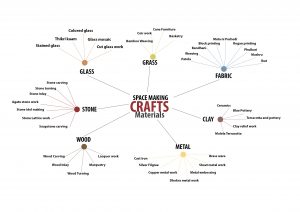 Figure 01: Division of various space making crafts on the basis of material, 2011
Space Making Crafts are an integral part of a culture of the place and they have been also a portrayal of a regional identity of a particular place with multiple associations of society, culture, religion etc. A singlespace making craft varying in expression, gave a uniqueness from the diversity of expressions, iconography, folklore, living patterns and myths and beliefs which varied from one region to other. Most appropriate examples of this would be paintings, frescoes and murals from different regions.
With distinct styles of ornamentation and surface decorations, the space making crafts are a storehouse of motifs, patterns, symbolic representations which have been constantly evolving throughout the history. Such motifs and patterns are often absorbed by a culture and then are disseminated across different kinds of media and are sometimes transferred to different kind of materials too. For example, the transfer of a motif from stone to wood, from handloom weaving to block printing, from the metal work to fabrics; and this has brought a unique amalgamation of the material and expansions of tool.
Figure 01: Division of various space making crafts on the basis of material, 2011
Space Making Crafts are an integral part of a culture of the place and they have been also a portrayal of a regional identity of a particular place with multiple associations of society, culture, religion etc. A singlespace making craft varying in expression, gave a uniqueness from the diversity of expressions, iconography, folklore, living patterns and myths and beliefs which varied from one region to other. Most appropriate examples of this would be paintings, frescoes and murals from different regions.
With distinct styles of ornamentation and surface decorations, the space making crafts are a storehouse of motifs, patterns, symbolic representations which have been constantly evolving throughout the history. Such motifs and patterns are often absorbed by a culture and then are disseminated across different kinds of media and are sometimes transferred to different kind of materials too. For example, the transfer of a motif from stone to wood, from handloom weaving to block printing, from the metal work to fabrics; and this has brought a unique amalgamation of the material and expansions of tool.
SPACE MAKING CRAFTS IN TRADITIONAL BUILT ENVIRONMENT OF INDIA
The vernacular structures and the traditional buildings in various parts of India show the integrity and the involvement of crafts in the built environment. There was no formalized methods of making, neither was a presence of a trained professional to help with the technical issues. They were constructed with the systems of making mentioned in the scriptures and ancient literature texts and with the skills of a craftsperson. The house forms of the desert areas, especially the bhunga structures in few parts of Gujarat and Rajasthan are one of the best examples of such built forms. Circular houses made of mud and roofed with thatch: these materials being highly suited the hostile desert environment. Also the clustering of huts, the arrangement of various open, semi-open and closed spaces was a reflection of their lifestyles. There was an involvement of craft in every element of the spaces thus created. Also as the users of the space were makers here, they added personalized creativity to the spaces in form of expressions which often carried a symbolic meaning implying auspiciousness and good fortune.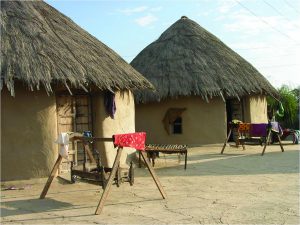 Figure 02: Bhunga Houses in Gujarat, 2011
Space Making Crafts added a character to the otherwise harsh and plainer life. It brought associations which were not merely related directly to the built form but also to a specific region, as the wooden constructions associates to the craft of making wooden houses in Kerala where they use the wood extensively. In Kerala the detailing of the wood craft is so immaculate that the wood has sustained till date.
The city palace in Udaipur is one of the prominent examples that showcase different extents of integration of crafts within the built environment with diverse approaches. It induces a sense of spatial quality to the built form. The presence of courtyards and pavilions indicate a spatial organization with reference of the climate of the region. The crafts have been also explored in making of balconies and jharokhas. This palace shows extensive use of crafts associated with glass and mirror work.
Another exclusive example of integration of crafts into the built form is the Adalaj step well located near Ahmedabad,where the stone craft is explored to its full potential which guides the form and massing, the scale and proportion, the space making elements and also the surface decoration. Here the integration goes beyond merely visual impactbut is also associated with various intangible factors. Apart from having detailed ornamentation on various surfaces, here craft helps in giving a spatial quality to the structure.
Figure 02: Bhunga Houses in Gujarat, 2011
Space Making Crafts added a character to the otherwise harsh and plainer life. It brought associations which were not merely related directly to the built form but also to a specific region, as the wooden constructions associates to the craft of making wooden houses in Kerala where they use the wood extensively. In Kerala the detailing of the wood craft is so immaculate that the wood has sustained till date.
The city palace in Udaipur is one of the prominent examples that showcase different extents of integration of crafts within the built environment with diverse approaches. It induces a sense of spatial quality to the built form. The presence of courtyards and pavilions indicate a spatial organization with reference of the climate of the region. The crafts have been also explored in making of balconies and jharokhas. This palace shows extensive use of crafts associated with glass and mirror work.
Another exclusive example of integration of crafts into the built form is the Adalaj step well located near Ahmedabad,where the stone craft is explored to its full potential which guides the form and massing, the scale and proportion, the space making elements and also the surface decoration. Here the integration goes beyond merely visual impactbut is also associated with various intangible factors. Apart from having detailed ornamentation on various surfaces, here craft helps in giving a spatial quality to the structure.
 Figure 03: Adalaj Stepwell, Ahmedabad, Gujarat, 2010
Figure 03: Adalaj Stepwell, Ahmedabad, Gujarat, 2010
CREATING AN IDENTITY IN INDIAN INTERIOR ARCHITECTURE
Over the past few hundred years or so, the notion of crafts has been constantly changing, the people who try to be enthusiasts of craft production are considered as intellectual utopians, or revivalists or people who are just trying to go back to the past and attempting to turn back the hands of time. The period after independence and the search for a new identity of being projected as Indian has rooted craft back into the interior architecture practices today vying for a new language in the practice. The late years of 1950s in India initiated a drive among many professionals working in architecture to create an identity of the emerging nation states. The major question being asked was how far were the emerging modes of practice in Indian interior architecture able to fulfil the physical, the social, cultural needs of people at various economic levels. There was also a drive to test the effectiveness of the climate controlling devices which were derived from the western methodologies. They were being critically analyzed for their suitability in the varied climatic zones across India. There also arose a debate regarding the relationship and continuity between the old and new built environment where the new one was reacted to as alien to the culture of the nation. The years between 1945 and 1980 began with the euphoria of independence – building a new India based on a concern for all people – but afterwards a materialistic, commercial and rationalist approach prevailed. (Lang and Desai, 1997, p.194) Different architects and designers responded to the complex matrix in different way. There were multiple viewpoints and attitudes which were seen towards crafts and interior architecture practices. And as discussed earlier, craft never was a new tool or was never a new phenomenon which had started after independence or in the last few centuries but it has been an active part of our lives. With the search of an identity of being associated with India and the richness of craft traditions the nation had, there are different layered approaches which started appearing in the practices of many professionals. Taking a critical glance at the various scenarios and trends that have emerged out of socio-cultural consequences in the country, Interior architecture practices in India have become multifaceted and complex. There are different architects and designers in varied projects using different facets of craft in their productions. While the ideas have been changing considerably, the impacts too have considerably varied with the ideas. There is involvement of various tangible and intangible factors which govern the integration of crafts within the built form. This is not merely a single approach but involves different people from different fields who come together to combine their ideas in a single space. For explorations associated with the emerging landscape in India, it is important to represent the diversity of architectural production in that context. With this multifaceted nature of production processes, clues about the form and nature of the emergent landscapes in India - the new practices that are reacting to the contemporary could be found. The emerging modes of practices discussed in the following section are in fact the indicators of the interior architectural landscapes that we can envisage in the future, they being illustrative of various issues that the Indian society and the architects and designers aspire to address. There are many degrees of the application and integration of crafts in the built environment which can be seen, each showcasing an individual interpretation of craft in the built environment. Many architects merely followed the modern masters by using concrete as the only expression in architecture; others challenged the multi-faceted practices of modern architecture in India by making the traditional knowledge and skills as one of their key principle while designing in architecture. Crafts in contemporary times have been manifested in different manners by different architects. These traditions become a constant source of inspiration to architects who attempt to embody, identify and find meaning in the design of new buildings.APPROACHES TOWARDS CRAFTS IN THE RECENT PAST
Recent examples from the last two decades showcase different approaches towards the use of crafts. This has been quite individual and has largely depended on the kind of the project and the concerned architect/designer. There are many approaches which may not show a full integration of crafts in the built form but embody craft traditions in them. The creation of Indian identity in many projects is not merely restricted to visual integration of craft practices, rather the manifestation is done at various levels. The reinterpretation of space making crafts, the elements from traditional and vernacular architecture and the influence of folklores, narratives or mythologies often have been translated. There could never be a case for or against this phenomenon, as there is no right way or wrong way of integrating crafts within the built environment. Rather they are just myriad manifestations and positions which an individual architect or designer takes while working with the world of crafts. Discussed here are the few key approaches which are seen towards interior architecture practices in India with specific reference to crafts. A few of the dominant ones were seen in many projects. They are:CRAFTS AS CONTINUUM OF TRADITIONS
Many architects and designers till date value craft as an important component of our lives, considering its socio-cultural and economic benefits. Craft is not an external layer which is to be added upon once the built form is complete, rather is itself imbibed in the building; building in an indigenous manner. Here the context, the site locations and understanding of the system as a whole becomes a crucial part. Many times such approaches might not show craft as a final visual outcome; rather the process might be a craft process. Tree of Life resort in Jaipur shows a deep understanding of the craftsperson and his skills in which the crafts are successfully integrated with the design philosophy. Without intervening much with the craftspeople, a freedom of expression is given while giving them a specific brief about the project. Figure 04: Tree of Life Resort, Jaipur, 2012
Figure 04: Tree of Life Resort, Jaipur, 2012
CRAFTS WITH EASE IN PRODUCTION
With the constraints of time and money, and scarcity of skilled craftspeople, the technology is improving with each passing day. This also initiates many approaches where craft is seen in the light of technology, hence rendering it possible for the architect and designer to incorporate it in the built form. This is to create a new language which emerges with the harmonious blend of hand and machine. For e.g. The luxury hotel, Raas in Jodhpur by AmbrishArora achieves a pattern of jaaliwhich was designed and derived by keeping in consideration the local skill of the person and the limitations of machine as a tool. This pattern was made which used machine for the initial cutting and the handwork to refine it and make it cleaner. Also at various places, the hand work is used extensively due to the limitations of the machine. Figure 05: Raas, a boutique hotel in Jodhpur, 2012
Figure 05: Raas, a boutique hotel in Jodhpur, 2012
CRAFTS WITH THE IDEA OF LOCAL PRACTICE
There are constant flips faced between the modern and the traditional. There is a constant strife between making something which is rooted within but is still placed in the modern and updated world today. This idea of placing a project within the global industry and looking for local solutions often leads to amalgamation of the two extremes, leading to a glocal approach which often looks for a local solution to a global issue or program. Here crafts are mostly used as a plug-in which often comes at a very late stage and is often used as a contrast to the minimalistic and modern expressions. Ayushakti, an ayurvedic hospital in Mumbai uses the traditional language integrating the wooden columns and the wooden roof which is juxtaposed with the planar columns and walls which are painted in the lighter hues.CRAFTS AS A DERIVATIVE TO A NEW LANGUAGE
This approach looks at craft as a dynamic process which evolves and should evolve with time; it does not focus on redoing things done before but shows a new way of looking at crafts. The involvement of craftspeople is at various stages depending on the requirement. This approach initiates ‘start afresh’ idea while there is an understanding of the context, construction methods and the culture. Often such practices do not have an existing framework to refer to, they evolve a new framework and methodology of working styles which is becomes a sustainable model developed in favor of both the architect/designer and the craftsperson. Nrityagram in Bangalore by Gerard Da Cunha is an extensive exploration of the skills and knowledge of the craftsmanship and the crafts. Though nothing has been imitated from what existed earlier, sufficient references have been taken forward to create a new language. Such practices evolve over a period of time based on the personal influences the practitioner develops with various facets of craft over time.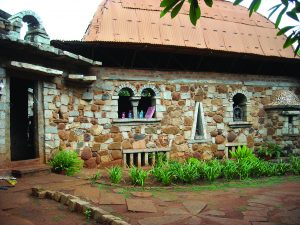 Figure 06: Nrityagram, Bangalore, 2011
Figure 06: Nrityagram, Bangalore, 2011
CRAFTS AS A TERM OR NOTION
In various projects, we often hear , ‘inspired from crafts’, ‘learned from crafts’, ‘ it was handcrafted’, ‘crafts used’ and so on, where the words become more important than the process and the outcome. These are the practices which merely use the notion of crafts or the semantics of the term crafts rather than going beyond this. These projects do not go beyond the terms yet are often considered as projects which show the use of crafts at different levels. Projects like Pearl Academy of Fashion, Jaipur which initiates their design concept from the craft of jaali making and concepts of traditional architecture of Jaipur refers to nothing other than this but still claims to be a catalyst for initiating crafts in the projects. Reflections The emerging modes of practices discussed in the last section are in fact the indicators of the interior architectural landscapes that we can envisage in the future, they being illustrative of various issues that society in India and the architects and designers aspire to address. Here, the medium becomes craft and craftspeople; including both the tangible and non-tangible factors thus making the construct more complex. In whichever manner these practices are formed, it is important to know that they struggle for authenticity and identity while attempting to resolve the intellectual complication and undercurrents of craft and culture in India. Few of the projects are intentionally linked with crafts, as the country is often know for its rich craft traditions. In various approaches, be it continuum of traditions or usage of mere terminologies, with this integration, the projects are recognized across various regions through such manifestations. There are different instances of the same phenomenon, for example the usage of traditional architectural forms and motifs along with crafts at the India Pavilion at the Shangai World Expo 2010 were suggestive of identifying India through Crafts. Indira Gandhi International Airport Terminal 3, New Delhi is another example where the huge installation of hand gestures against copper discs portrays the exuberance and cultural richness of crafts. Such instances are slowly increasing and the trickledown effect of such approaches is manifold. The craft traditions practiced for generations in the built landscape are being redesigned and remodeled, where each expression is unique and independent of others. With the advancement of technology and division of labour, the manifestations have considerably changed. Earlier where the craft was practiced as a community, it is now often practiced solely by individuals. A lot of exchange of ideas between various cultures, regions and people are becoming evident in a country where the interior architecture spaces are seen an interaction between all these. Traditional interior spaces ensured the expression of a regional and cultural identity, being made and designed by the local people and craftspeople using the available resources and techniques. The optimum use of the resources and its relative geographical isolation, gave a local flair and portrayed a unique identity of the region. Post liberalization, the conception of interiors has changed drastically, with myriad manifestations and varied attitudes, various works of interior architecture still claim to be 'Indian' merely with the integration of craft practices. What has remained constant is the connection of crafts with the nation. Even though the methods have changed, the ideologies have changed and so have the tools and techniques; but the impact remains the same. Like earlier times, Space Making Crafts are lending a unique identity to Indian interior architecture practices. The only difference which remains is that the horizons have broadened beyond region and community; and extend to the nation as a whole. Select References Adamson, G.(Ed.), 2010.The Craft Reader. New York: Berg Publisher Balaram, S., 1998.Thinking Design. Ahmedabad: National Institute of Design Bhatt, V. and Scriver, P., 1990.Contemporary Indian Architecture: After the Masters. Ahmedabad: Mapin Caan, S. 2011.,Rethinking design and interiors: human beings in the built environment, London: Laurence King Pub. Ltd. Chattopadhaya, K., 1980. India’s craft Tradition, New Delhi: Ministry of Information &Broadcasting Coomaraswamy, A.,1909.The Indian Craftsman, London: Probsthain& Co. Jaitely J., 1990.The Craft Traditions of India, Lustre Press Pvt. Ltd. Lang, J., Desai, M. 1997. Architecture and independence: the search for identity India 1880-1980. Toronto: Oxford Uni. Press Mehrotra, R., 2011.Architecture in India since 1990. Mumbai: Pictor Publishers, Pye, D., 1995.The nature and art of workmanship.London: The Herbert Press Vyas, H.K., 2009.Design the international Movement: with Indian Parallel. Ahmedabad: SID Research Cell|
For PUTTING IDEAS FIRST XII, a monthly discussion series on crafts, aesthetics, sustainable livelihoods and advocacy Dr. Ajit Kanitkar gave a talk on the Credit Flow to the Handloom Sector: Appraisal of the Current Scenario on Tuesday, 27th June, 2006 at India International Centre. The talk was based on an exploratory study was funded by All India Artisans and Craftworkers Welfare Association (AIACA) and conducted by Dr. Kanitkar. Objective of the Study
|
Issue #009, 2022 ISSN: 2581- 9410 In 1849 when the Sikh kingdom was annexed, the entire Punjab came under the rule of the East India Company. Thereafter, British Raj continued for almost a hundred years bringing stability to the region and exposure to Western culture. The new culture not only had its impact on the dress and lifestyle of the people but also impacted styles of embroidery in Punjab. With increased Westernization and changed living styles, European style elevated furniture found a place in many homes. With the furniture, articles of household linen also came into usage as was the norm in European homes. As the availability of these in the market was limited, most women in Punjab made their own linen and embroidered them with European motifs. New embroidery styles evolved in the region, which were influenced by European styles in colour and design. These were so popular that almost everyone from the cities to the villages did some of these embroideries. Although the time period covered here is before Partition took place but the embroideries mentioned herein are from the region of Punjab, which is now in India. During the nineteenth century in India, Western style articles were made only for Europeans. Many writers have endorsed this view. Among them Forbes J. Watson (1866) mentions Western style articles like table napkins, doilies and pocket-handkerchiefs being used only by Europeans. (P95 Watson, J. Forbes, The Textile Manufactures and the Costumes of the people of India, London Printed for the India Office, 1866 ) T. N. Mukherji (1888) writes about embroidered mantel covers, table covers, chair covers, tea-cosies and cushions purchased by the Europeans. (p373 Mukharji, T. N., Art Manufactures of India Printed by the Suprintendent of Government Printing India 1888 Reprint Navrang New Delhi1974) Much later, Traveskis in 1930s also writes about embroideries being done on some articles for European use only. (p208 Traveskis Punjab of Toady 1932) Embroideries The three popular handiworks of the early twentieth century Punjab were the dasooti, bharnvi and crochet. One of the most popular subject of embroidery was that of Crinoline ladies which was embroidered on articles like tablecloth, mantel covers, fire screens, etc. in both dasooti and bharnvi styles. By interviewing people around Punjab as well as dating the surviving pieces, it is established that these styles became popular in the first decade of the twentieth century, although some may have arrived earlier in Punjab. They continued to be popular handcraft for women for many decades after that. Women did these kind of embroideries for sometime even after India gained independence in 1947. The name dasooti comes from the cloth on which embroidery was done. Cotton cloth of different thicknesses was woven in Punjab in second half of nineteenth century. If woven with one thread used for warp and weft, it was called eksuti, if it was with two threads together; it became dosooti, and similarly, tinsuti (three threads) and chausuti (four threads). (p 7 Powell, B.H. Baden, Handbook of the Manufactures and arts of the Punjab; vol-2 Lahore, Punjab Printing Company, 1872) Dasooti embroidery was really cross-stitch embroidery with geometric motifs or stylized flowers on white material also known by the same name. This was much later, also done on coloured cloth. The texture of the dasooti cloth was such that it made it easier to count the threads thereby making embroidery easier. Bharnvi as the name suggests was an embroidery in which the prominent stitch was the filling stitch, though other stitches were also used. The most widely used material for it was white lattha, a kind of coarse, generally white, cotton fabric, commonly used in Punjab. Black cotton velvet was also popular. A crochet edging finished some of the bharnvi embroideries, especially those done on white. Some of the cotton thread used for dasooti and bharnvi came from abroad, and eventually, began to be manufactured by Delhi Cloth Mills (DCM). Popular designs were patterns like roses, hollyhocks and tulips that had affiliations with the West. It would be safe to say that every lady from a generation before independence would have given dasooti and bharnvi embroidery a shot at some time or the other. Both these styles were taught in schools from the sixth standard onwards and these were instrumental in spreading it widely. Along with these, new handiwork crochet and knitting were also taught from sixth class onwards. Western motifs were the favorite with the teachers and the students. Girls from a very young age learnt the new styles and designs. Darling writing about this says that what was being taught in the village schools was more suitable for the city girls. He did not see advantages of teaching village girls to make tablecloths and bibs and lace and woollen scarves, when they could be learning to embroider their own clothes. (P222 -223 Darling, Malcom Lyall –Rusticus Loquitur or The old Light in the Punjab Village – Humphry Milford Oxford University Press 1929) Purely a domestic skill, these embroideries were passed on from person to person; girls would often look at the motif or design made by another girl, and copy it. Most designs had similarities with European designs, like a bunch of roses, a basket with flowers, tulips hollyhock etc. Magazines and iron-on transfers By the early twentieth century, magazines, pattern books and iron-on transfers had started coming from abroad and were available in the local city shops in Punjab, and were a big factor in increasing the popularity of European designs and motifs. Women’s magazines and books, printed in France and England found their way to India. Good Needlework and Knitting Magazine, Needlewoman and Needlecraft, and Butterick Pattern Company’s guidebook were all available in Punjab’s local shops by early twentieth century. The pull out iron-on transfers in these publications came along with instructions that, often, even gave the numbers and colours of the threads to be used, which were, in turn, imported and available in local shops. Both Briggs and Dighton transfers were used and have been found from homes of people all over Punjab. With all this information and material coming from abroad, the designs and embroideries made by the women in Punjab became similar to those done by women in England or Europe. While there were many patterns and designs that had affiliations with the West, the most interesting was the pattern of Crinoline ladies. Fascination with this motif is illustrated also by the fact that some even purchased goods with this pattern. An example of this is found in a straw bag from 1943 or 1944, which was preferred choice of an educationist who was working at Lawrence School, Ghora Gali, Murrie (now in Pakistan). Here embroidered crinoline girl is surrounded by hollyhock. This bag from England also has the English newspaper visible in parts where the cover is worn out. Crinoline What really are crinoline dresses? This is the period when voluminous dresses were worn in Europe from 1850 to 1869. As the width of the dresses increased so did the layers of petticoats. Many layers of stiff fabric made of horsehair (crin - meaning horsehair) and cotton or linen was used to make petticoats that gave the desired volume. This is how the period became known as the Crinoline period. (P 297 Tortora,P.G., Eubank,K., Survey of Historic Costumes, Fairchild, New York 2006) As the width of dresses was large the gown had to be lowered onto the superstructure by servants with the help of poles. Women needed maids to help them dress up. (P 237 Batterberry, Michael and Ariane, Fashion Mirror of History, Greenwich House, 1977 ) This was beautifully depicted in the 1939 movie Gone With The Wind, set in the backdrop of the American Civil War, where the protagonist, Scarlett O’Hara, was assisted by the household help, Mammy, to put on her dresses over many layers of petticoats. Later, the multiple layers of petticoats were replaced by a series of whalebones or steel hoops stitched onto tapes, or into the fabric of the skirt. Shapes of petticoats changed according to what were considered fashionable silhouettes. Later, the skirts themselves came to be called crinoline. While majority of women stuck to Indian clothes throughout the British Raj, there was a small section who did wear Western clothes. These belonged to either prominent Christian families or were from the royal families who did wear dresses and some of them even crinoline skirts. Perhaps, the use of the petticoat with saris, initially by upper-class Indian ladies, took inspiration from the layers of petticoats worn by European ladies for their dresses. Saris were earlier worn as a single unstitched garment. As blouse and petticoats were derived from the European dresses they also adopted the same name. To everyone, from dhobis to maids, they were known as a petticoat and a blouse. Coming back to the embroideries, the crinoline motifs were embroidered with both bharnvi and dasooti techniques. Many iron-on transfers found homes in Punjab from different regions have crinoline ladies in various settings. Embroidery transfers in Europe were sold in large numbers for over a hundred years, from the time of their invention in 1875. These enabled designs to be transferred in much less time than by conventional means, like pricking patterns on paper and transferring it on the fabric by dusting with powder. Iron-on transfers were commercially available in Europe by the end of the nineteenth century. These designs consisted of line drawings made with ink on thin paper. The ink had a low melting point, and the application of a hot iron transferred the design onto the fabric. (P4-6 Proctor, Molly G 2009) The manufacture of iron-on transfers, is attributed by some to the workers of William Briggs. Amongst Briggs’ first transfers were those used to make scalloped edgings for linen, underclothing and children’s dresses. (P115 Beck, Thomasina 1995) The other company popular for iron–on transfers was Dighton. Transfers from both these companies were popular and were used by women of Punjab. Although crinoline dresses were worn only till 1869 in Europe but women of Punjab continued to embroider them even as late as 1940s and 1950s. Perhaps most women of Punjab might not have even seen such dresses and yet it intrigued them and formed a popular subject for articles of household use especially for tablecloth where they were embroidered in a circle. Many people from Punjab are familiar with this motif as they would have seen them on some article or the other that was embroidered by their mothers or grandmothers. [caption id="attachment_192113" align="alignleft" width="229"]
 1930s Simla Fire screen with crinoline lady done with dasooti style of embroidery[/caption]
[caption id="attachment_192112" align="alignleft" width="300"]
1930s Simla Fire screen with crinoline lady done with dasooti style of embroidery[/caption]
[caption id="attachment_192112" align="alignleft" width="300"] 1943 or 1944 straw bag has crinoline lady surrounded by hollyhock. It belonged to an educationist who was working at Lawrence School, Ghora Gali, Murrie (now in Pakistan)[/caption]
[caption id="attachment_192111" align="alignleft" width="272"]
1943 or 1944 straw bag has crinoline lady surrounded by hollyhock. It belonged to an educationist who was working at Lawrence School, Ghora Gali, Murrie (now in Pakistan)[/caption]
[caption id="attachment_192111" align="alignleft" width="272"] Briggs iron-on transfer, showing Crinoline ladies. This is from a house of a lady in Ferozepur who purchased it from a local shop[/caption]
[caption id="attachment_192110" align="alignleft" width="261"]
Briggs iron-on transfer, showing Crinoline ladies. This is from a house of a lady in Ferozepur who purchased it from a local shop[/caption]
[caption id="attachment_192110" align="alignleft" width="261"] 1940 Ferozpur Bharnvi style with crinoline lady on a mezposh (table cloth)[/caption]
[caption id="attachment_192109" align="alignnone" width="208"]
1940 Ferozpur Bharnvi style with crinoline lady on a mezposh (table cloth)[/caption]
[caption id="attachment_192109" align="alignnone" width="208"] Late nineteenth century, Jalandhar, Polly Golaknath (1849-1924) in a crinoline skirt made of check cloth that was in fashion in Europe.[/caption]
Late nineteenth century, Jalandhar, Polly Golaknath (1849-1924) in a crinoline skirt made of check cloth that was in fashion in Europe.[/caption]
|
|
SAJJA Sajja means decoration and adornment. Gotipuas enhance themselves with chitra (painting) on their body, highlight their eyes with black kajal. Some perform Odissi dance by wearing tahiya (head gear). Such is the beauty of culture that people in villages where every pratha live like satiya (truth) is believed and performed by connoisseurs. |
| Sajja On the day of Sahiyatra gotipuas in dandashi take the form of Goddess Durga, ritually decorate their feet lined with Alta (red liquid) wear a sari and hand and face mask made of paper mache. After transforming into the revered Goddess Shakti dances in anger. |  |
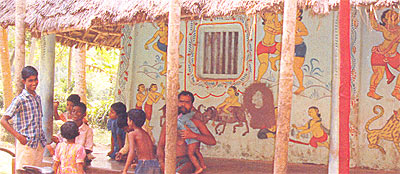 |
Dandasai of Chandanpu in Puri district is the shrine where various chitrakars reside. Dandasai village walls decorated with kantha chitra (wall paintings) narrates folklore of Qrissa, Chandi, Chamuda and Shakti in various forms of bhav (expression) and bhanga with bold figures in vibrant colours. |
| Traditional Chitrakar community paint the walls of houses, temples with beautiful borders and stories. Picture show how the fearsome naked Goddess Chandi drinks her own blood. People here live with the tradition and follow the inherited craft from their fore fathers by continuing pattachitra, paper mask, and gotipua dance. | 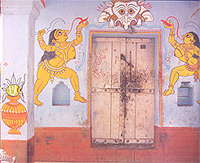 |
 |
Pattachitra painting is ritually connected with the Lord Jagannth temple in Puri. For the Chitrakars in the Puri painting is an expression art as devotion towards the God, depicting various myths and legends of Purana, Ramayana, Mahabharata and Radha Krishna. |
| Chitrakars preparing patti, patua, patta or the base canvas with layers of fabric with tamarind seed paste, after drying it is rubbed with soap stone to make the surface smooth and ready for painting. | 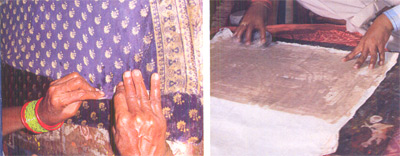 |
 |
After the patti is prepared natural colors are prepared using natural sources and then mixed with Kaintha attha (latex) and rubbed inside the coconut shell to make it viscose fluid before lining the figures drawn on pattis, which was originally done using katha badi (stick) and later with the brush made of rats hair. |
| Very few people know about the traditional playing cards Ganjapas which narrates the dasavatar (ten incarnation) is a languishing art. |  |
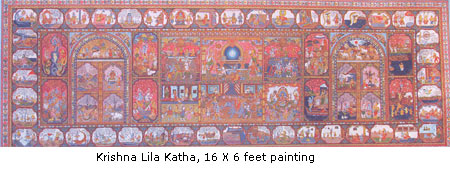 |
| This outstanding pattachitra painting in 16 X 6 feet depicts Krishna lila Katha done by the National Award winner Niranjan Maharana. This painting has been acquired by the National Gallery of Victoria, Melbourne. Niranjan Maharana is a Chitrakar from Chandanpur, Dandasai Village and has inherited the skill from his father Nursingha Maharana and grandfather Panu Maharana. | 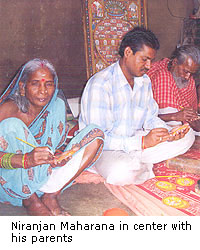 |
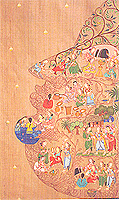 |
Rajja is the festival of earth goddess worshiped by the farmers of eastern Odisha. This time the Dharini or the earth Goddess is in her fertile period, farmers do not plough the land, women adorn themselves during these four days when the earth mother is considered to be in fertile period.. |
| Pralaya Patra, when nothing was left in this world, when everything was shattered and finished, there floated a pralaya patra where Vishnu lay on the ananth shayana watching the entire universe. In this image Vishnu, the keeper of this world has been depicting in his incarnation as Krishna balbya lila inside the pralaya patra with his symbolic representation through padma, gada, chakra, shanka and peacock feathers | 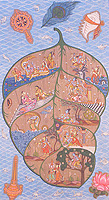 |
 |
SAVITRI KATTHA Savitri the bountiful, beauty and intelligent daughter of King Ashvapati made up her mind her to marry the woodcutter Satyawan, whose father lost his kingdom and his vision forcibly done by the king Shailya. Astrological predictions foretold that Satyawan may not survive for long. Undettered Savitri left her royal throne and stayed in the forest after getting married to Satyawan.On the day when the God of death, Yama had sent his messengers to get Satyavan, such was her chaste and fire that they could not take away Satyavan's body. Yama himself decided to come, but Savitri pleaded with him not to take her husband away. Yama blessed her with many wishes other than her husbands life. Savitri asked for a hundred sons, for King Ashvati, her father-in-law his vision so that they could they see their grand children and the return of his kingdom.Later Yama realized how clever she had been and left Satyavan with Savitri. |
| Saraswati consort of Brahma, the creator, she is the Goddess of knowledge and personifies nature’s wisdom. Veena is her instrument, hansa is her messenger depicting purity. |  |
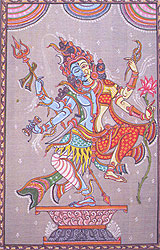 |
Ardhanari represents androgyne body, where Shiva and Shakti fuse together to form one. Shakti was born as Parvati only for Shiva. |
| Radha Krishna in Jugal posture embracing each other, bhav (expression) symbolizing atma and parmatma, matter and soul together complete the cosmos. | 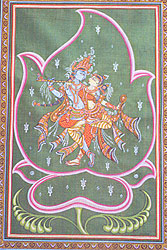 |
 |
Vishnu took the form of wild boar, Barah avatar incarnation and rescued Bhudevi, the earth Goddess from the demon Hiranyakashyap and embraced her. |
The right to a livelihood is denied to millions of the world's poorest. Among those living in abject poverty are artisans in India. Their centuries-old means of earning a living has been shattered by modernisation and industrialisation. India's Artisans Status Report states: Today most of India's artisans are struggling for survival. Many have given up and moved away from their traditional occupations. Others cling on desperately not knowing what else to do or to whom to turn. Their skills, evolved over thousands of years, are being dissipated and blunted. Their progeny are not willing or able to carry on the family tradition, and a rich culture is on the verge of extinction. (Satyanand & Singh, 1995, p.1). Strengthening the economic viability of craft communities is important to the sustainability of artisan livelihoods. This is a matter of survival for artisans. It is also necessary for the preservation of the world's cultural diversity. Interventions based on the modernisation paradigm, and its narrow economic criteria of material progress, are not likely to create viable craft producing groups. This paper argues that there are other criteria by which the value of artisan activity can be framed. A more inclusive and holistic framework, congruent with an emerging paradigm of sustainable rural development (Shepherd, 1998), has potential to support the dignity and autonomy of artisans, the continuity of indigenous knowledge and cultural diversity, and the sustainability of local economies and communities. Artisan Livelihoods The crafts sector of the Indian economy is comprised of an estimated twenty-three million artisans (Dastkar). In terms of employment and contribution to the economy, this sector is second to agriculture. Many agricultural and pastoral communities also depend on their traditional crafts as a secondary source of income in times of drought, lean harvests, floods or famine. For women, craft is the largest arena of employment, as they use craft to enter the economic mainstream to become wage-earners (Tyabji, 1999). Between 1961 and 1981 there was a 29% decline in artisan population, and the number of women working in the artisan sector dropped by 73%. This trend accompanied a major shift from small scale to large scale industries, as well as a decline in household sector work and an increase in non-household sector work (Satyanand & Singh, 1995, p.15). Artisans are among those in India who have the lowest social and economic status. Many are lowest in the caste hierarchy. Exploited by traders and middlemen, artisans have very little income. Indebtedness is a way of life. According to some scholars every feature of economics, society, and state was designed to keep artisans in their place in the scheme of things and strictly limit their mobility. Lack of education, illiteracy, and restrictive caste barriers give many artisans a fatalistic acceptance of their low social status. The words "artisan" and "craftsperson" are often used interchangeably and I will continue this use throughout this paper. The Hindustani word for craftsperson is "one who works with his (sic) hands" (Dastkar). This relates to the root meaning of manufacture, "to make by hand" (Merriam, 1975). The earliest specialists of manufacture made goods for everyday use such as, baskets, cooking vessels, agricultural implements, cloth, footwear, and ornaments. They also made sacred objects in accord with religious beliefs and ritual occasions. Throughout millennia of Indian history, craft production has been a major means of livelihood. A system of manufacture was based on hereditary skills and forms of expression, and markets evolved through a traditional patron-client relationship. Intrinsic to the Indian way of life, craft work was essential to village and trade economies. By the first century A.D., overland and maritime trade routes linked India with China, Mesopotamia and Rome. During Moghul rule, artisanal activity flourished and India exported vast quantities of textiles to markets throughout the world, attaining industrial supremacy until the end of the 18th Century. Under British rule, the traditional Indian manufacturing economy was destroyed by means of a vast increase in imports of British manufactured goods to India, the imposition of protective tariffs against Indian exports, a drain of wealth in the form of raw materials to England, and the emergence of capitalist modes of production. Millions of artisans were forced into starvation. Pandit Nehru attributed India's appalling poverty to the British destruction of India's traditional artisan economy (Bhasin, 1997). Although Gandhian economics envisioned the continuity of craft as an essential and meaningful part of the Indian economy based in rural villages, the rulers of modern India did not take this development perspective seriously. Political and societal choices favoured modernity over tradition. Based on the conviction that artisans, their skills, and their ways of life have social and economic significance, India's Artisans Status Report was compiled to provide a sensitive overview of the artisan sector. In defining "artisan," the report describes essential characteristics as follows: a person who makes goods or provides services to others using his or her own skills and labour. Further, artisan skills are traditional, which means their skills have been historically associated with a particular artisanal activity even though these may have been adapted over time to evolving technologies, materials, and products. Artisans work individually or at the household level and they are self-employed in the sense that they enjoy the whole produce of their labour, or the whole value added to the materials on which their work is based (Satyanand & Singh, 1995). The status report outlines major reasons for the current state of poverty among artisans, including: (a) disappearing markets, (b) technological obsolescence, and (c) poor government planning. First of all, there has been a dramatic shift in consumer choice from artisanal goods to factory made ones. This has been the result of a number of factors: (a) aggressive marketing and advertising strategies of the organized industrial sector; (b) mass production of goods of uniform quality at prices which artisans cannot easily compete; (c) financial incentives, benefits, and reliefs extended to the organized industrial sector but ordinarily not available to artisans; (d) preferential access to credit, raw materials and infrastructure extended to organized sector but artisans have handicaps such as, a lack of capital to purchase good quality materials in bulk, scarcity of raw materials, and absence of infrastructure in the way of work sheds, power, and storage space; and, (e) preoccupation with urban and export markets which diverts energies and resources that otherwise could be invested in building up local and sustainable markets for artisan products. Second, technological advances have benefitted the factory sector in terms of efficiency and quality of output, and machines can imitate intricate designs that once were the exclusive domain of artisans, passed down from generation to generation. Dependence on capital-intensive western technologies and lack of investment in indigenous technological research has resulted in the failure to develop technologies appropriate to the craft sector. Third, after 40 years of planned development, government planners remain conceptually confused about the role of the craft sector in India. Some stress the importance of keeping the cultural heritage alive. Others emphasize the employment generation potential of the sector. As a consequence, artisans have been viewed as part of the welfare sector, propped up by subsidies and grants, rather than as part of the core economic sector (Satyanand & Singh, 1995). According to Bhrij Bhasin, former director of the Handicraft and Handloom Export Corporation and the Cottage Industries Emporium of the Government of India, A great deal of lip service is paid by the government in India to crafts production and development, but official policy is actually active in destroying the traditional crafts support base. On the one side, there are extremely powerful forces of industrialism, capitalism, and consumerism and, on the other side, there is the ruling elite actively welcoming these forces. Crushed in between is the humble artisan. (Bhasin, 1997 p.2). There is enormous diversity among the groups called artisans or craftspeople. India's Artisan Status Report differentiates eight groups of artisans according to the kinds of raw materials they work with: metal workers; wood workers; potters; textile workers; gem polishers and jewelers ; cane, bamboo and fibre workers; tailors; and leather workers. Each artisan group is further differentiated according to the parameters of: location (rural, urban, semi-urban); access to raw materials (procured independently, supplied by customer or by co-operative); skill or technology used (manual, semi-automated); purpose of product (utilitarian, decorative, repair); market site (village, urban, export); sales channel (market, trader, co-operative), and employment status (self-employed, wage earner, co-operative). When this range of parameters is applied to artisanal activity, there are over fifteen thousand differently identifiable types of artisans in India (Satyanand & Singh, 1995) and the need for specificity within particular contexts is clear. The nature of materials, skills, products, and employment are central to the above classification of artisans. This classification is congruent with the use of the word "crafts" to mean "those activities that deal with the conversion of specific materials into products, using primarily hand skills with simple tools and employing the local traditional wisdom of craft processes. Such activities usually form the core economic activity of a community of people called craftspeople" (Panchal & Ranjen, 1993, p.7). This definition of crafts, however, gives emphasis to the application of indigenous knowledge to the processes of transforming materials into products. There are also cultural dimensions and intrinsic meanings associated with being an artisan or craftsperson. For example, particular features of an artisan's environment--natural, social and cultural--shape artisan identities and world views. These in turn influence what an artisan makes and why he or she makes it. Secondly, knowledge, aesthetic sensitivity, and imagination are critical attributes which inform the processes by which a craftsperson works well with tools and materials. Third, meanings both inspire and emerge from the creative process of making things. The world of the artisan's work is imbued with meaning. Eliade (1978) writes, "The imagination discovers unsuspected analogies among different levels of the real; tools and objects are laden with countless symbolisms, the world of work--the micro universe that absorbs the artisan's attention for long hours--becomes a mysterious and sacred centre, rich in meanings" (pp. 34-35). The domain of artisan livelihoods encompasses values and sensibilities that are not only material. I emphasize the primacy of artisan knowledge, as well as material and non-material requirements and influences. An artisan is part of a local and extended community of people with knowledge and ability to make particular objects by hand using relatively simple tools and equipment. His or her knowledge is developed over a long period of observation and practice--observation of a proficient or master craftsperson and practice in refining the variety of skills required to make a craft item well. An artisan's knowledge encompasses hand skills, visual and creative thinking, aesthetic sensibility, and familiarity with craft and design processes and forms. Having acquired detailed knowledge related to the materials, tools, and forms and processes of his or her craft, an artisan produces objects that can have functional, aesthetic, and cultural value. Qualities of craftsmanship, such as, attention to detail, imagination, innovation, and refinement distinguish excellent craft work. The life and work of artisans exemplify particular ways of knowing and ways of being in the world. However, to sustain the continuity of their work and means of livelihood, an artisan requires access to appropriate materials and information about the kind of products that potential customers need or want to buy. Craftspeople need to know how best to reach their buyers and how to ascertain the value of their work and what price to ask. Changes in the marketplace have direct impact on artisans and influence the perspectives and attitudes of the communities to which they belong. Craft and Sustainable Development Tensions exist at the intersection between indigenous artisan knowledge and global economic forces at the end of the twentieth century. There is an apparent lack of fit between the world of the traditional artisan and that of modern urban-based societies. There is incongruence between indigenous artisan meaning systems and the operation of modern markets. In terms of quantity and speed of production, artisan technology and skill cannot compete with industry. However, the picture changes dramatically if you take the view that "the highest technical skill is hand skill....the human heart and hand together provide the highest technology that can ever exist" (Singh, 1997). A definition of artisan as producer of goods and services for others underscores the difficulties for artisans in the context of the modern economy. There is a swing against small scale village industries and indigenous technologies. Multinational corporations--favouring macro-industries and hi-tech mechanized production, and supported by sophisticated marketing and advertising--have edged out traditional rural marketing infrastructures. Operating on a small scale, artisans can't compete. They are exploited by middle men and trapped in cycles of debt. They are seen to be backward and not getting on with developing along western lines of progress. Their work is considered "ethnic" by urban elite. Artisans are often forced to abandon their traditional occupations, migrate to urban areas in search of a "better life", and take up unskilled daily wage labour to earn a subsistence livelihood at wages that are often better than what they can obtain from their craft. From another viewpoint, based on a more inclusive definition of artisans as people who have valuable knowledge, skills, and sensibilities, the loss of artisan livelihoods is not only an economic problem, it is also an erosion of cultural diversity. With artisans "drowning in global monoculture" (Stackhouse, 1999), the decline in artisan livelihoods worldwide is a global as well as local issue. Alarm is being sounded for the loss of ecological habitats and biodiversity worldwide. A similar alarm needs to resound for the loss of highly developed craft skills and knowledge, and the ways of life that are a part of an artisan's work and environment. Shepherd (1998) argues that old paradigms of development are breaking down and a new paradigm of sustainable rural development is being formed. Conventional development, a part of the modernisation paradigm, is guided by notions of material progress--growth of income and wealth, and poverty alleviation. Despite promises of prosperity, development schemes based on the goals of materially wealthy western societies have failed on a number of counts. They have failed to benefit the poor. Instead, the poor are victims of development projects that have destroyed land and resources, displaced traditional occupations, and ruined local economies. Particularly in rural areas, the poor have been marginalized by the development path taken by their societies. They have been devastated by the environmental degradation and social deteriorization that has come in the wake of development projects (Sainaith, 1996, and Sheppard, 1998). The word livelihood is commonly defined in economic terms as the minimum necessary to support life, or the means of subsistence to obtain the necessities of life. This definition is congruent with material values of the modernisation paradigm, but inadequate to account for non-material values that are integral to traditional livelihoods. The language of sustainable development gives new meaning to the word livelihood, more aligned with the concerns of artisans. Sustainable development refers to improvement in livelihoods which does not undermine the livelihoods of future generations (environmental sustainability) (WCED, 1997) and can be sustained over time (institutional sustainability). Livelihoods refer to much more than just income and wealth: quality of life and of society, security, and dignity might be just as important to those whose livelihoods need improving. (Shepherd, 1998, p.3). In the context of economic and cultural globalization, can the craft sector be reframed within the emerging paradigm of sustainable rural development to protect local livelihoods and environments? Can artisans procure a sustainable livelihood by means of their craft skills and knowledge? The inadequacy of the modernisation paradigm to address the concerns of artisans necessitates a more congruent framework of analysis and criteria of progress to address the challenges of improving economic viability of craft communities. Sustainable rural development represents a shift from an industrial approach to technology development "to an organic or holistic approach, with sustainable improvement replacing profit as the implicit objective" (Shepherd, 1998, p. 10). The values and processes of sustainable rural development provide a relevant framework for formulating appropriate responses to challenges of improving artisan livelihoods. In the following I focus on four key issues: (a) local economy; (b) dignity and autonomy; (c) participation; and (c) learning. Local economy There is a growing awareness that solutions to complex problems among the rural poor may be found in small scale, local economic activity, with the use of low levels of technology and application of indigenous knowledge and skills. There is a movement towards local production for local consumption, reclaiming the economy in the service of people and communities. Microenterprise and village-level savings and credit associations create opportunities for the poor to increase their survival chances and economic security. The craft sector has been tragically neglected. However, there is an increasing emphasis on redefining craft as an economic and development activity. With enormous resources of fine skills and technical knowledge, the craft sector represents an opportunity for employment for vast numbers of people who are otherwise involved in agricultural activities; and for some people, craft represents their only source of sustenance. Numerous development interventions use craft as a means of income generation. Craft is seen to be a catalyst for economic and social revitalization of fragmented and marginalized communities. Craft can also be an important entry point for aspects of development such as, education, health, community building, women's emancipation, and the discarding of social prejudices (Tyabji, 1999). Craft development interventions confront unique problems and challenges. In order for the craft sector to develop as a means to sustainable employment, intervening agencies need a working knowledge of design, product development, and marketing. Often NGOs and development agencies view craft as an income generation tool but they do not understand the problems of craft production and sales. Dastkar, an organization founded in 1981 and based in Delhi, works with 65 craft-producing groups throughout India to improve the economic status of artisans and promote the survival of traditional crafts. They provide input in terms of craft productivity and sales to help traditional artisans and low income craft groups to bridge the gap between rural producers and urban consumers. Dastkar's programmes include: skills upgrading, credit, raw materials, product design and development, management training, and marketing support (Dastkar). On the other hand, designers who work in craft development must be aware of the diversity of craft traditions and the problems and capacities of particular artisan groups. They need to be able to sensitively interpret a craftsperson's tradition and design products that adapt traditional skills to suit contemporary tastes and needs. It is important that craft design and marketing interventions are not alien or in conflict with the artisans' social, aesthetic, and cultural roots. In their work with craftspeople, Dastkar tries to create relationships of mutual understanding and trust, rather than imposing solutions from above. Dignity and Autonomy Craft products can be exchanged for money and they are expressions of a cultural heritage, but what is alive is the skill of the artisan who makes the objects. Increasingly, craft development organizations that aim to help artisans attain economic self-sufficiency put the artisan at the centre of the process. They focus on the artisan as a human being with basic needs and rights and as a skilled worker who has abilities to make beautiful and useful objects. This represents a shift in emphasis from the craft product, and it's role in the Indian economy, to the artisans themselves who have a significant role to play in finding solutions to their problems. Where the making of craft is a matter of survival, the objective is to help artisans survive with dignity. Autonomy, freedom, dignity, and peace--intangibles that have been neglected in the modernisation approach to development, are integral to the sustainability paradigm (Shepherd, 1998). These are essential qualities that enable people to feel secure enough to take control of their means of livelihood and to make choices about their future. Artisans who benefit from craft development initiatives gain self-respect and confidence that their own abilities can make a difference to the quality of their lives (See Jongeward, 1999a and Tyabji, 1999). Participation One of the implications of putting artisans at the centre of craft development interventions is the need to involve artisans in processes of change that effect what they make, how they work together, and the life of their communities. The importance of participation in development processes is increasingly recognized. This indicates a change in perspective about who's needs are first and what's important. In practice, encouraging participation means making spaces for the poor and marginalized to express their needs and concerns. It also means encouraging their involvement in decision-making and fostering a sense of responsibility for their own affairs. Dastkar focuses on developing cohesive craft communities. The process of group formation and creating awareness and responsibility is a gradual process that can take longer than the process of designing and production, but Dastkar recognizes the importance of participation, especially for empowering women. They have seen how artisans gain confidence through participation, planning, and organizing local activities themselves. Learning There has been a search for alternative forms of development that promote learning and innovation rather than blueprint and top-down styles of development projects. Shepherd (1998) says, "If an agency is seeking to advance participation of the rural poor, it must develop the capacity to learn from its experience, and from the wider environment in which it operates. Similarly the rural poor themselves will learn from experience" (p. 138). When rural development takes place as a learning process, research, analysis, reflection, and evaluation become central thinking activities. Also, participatory reflection and analysis become integral to the design, implementation, and evaluation of activities. Learning is emphasized among all those involved in the transformation process of improving livelihoods. Organizations for craft development have a critical role in the development of new products and markets for artisans but they also have a role in fostering learning among participants and beneficiaries (Jongeward 1999b). Artisans themselves are learners when they are trained to use new tools or equipment or to make new products. They can learn every aspect of design and production in order to adapt their own artistic knowledge and understand the function of new products. Learning to work together involves learning to feel secure enough to trust one another and take the risks of trying out new things to do and ways to think. Given opportunities to learn about designing, problem solving, and managing, new leaders and innovators can emerge within community-based organizations. Craft organizations are strengthened when they emphasize a learning orientation. A striking example is the Bangalore based Foundation for Advancement of Craft Enterprise and Skills (FACES) which was started in 1996. FACES adopted an open learning systems approach in their efforts to foster the craft community, develop the quality of craft, create equity for the tradition, and trigger entrepreneurship in the community. FACES asks a number of difficult questions about how the values, meaning frames, and identities of artisans can be preserved even as they become integrated into the modern market and society. Recognizing that craft interventions are not usually seen as community work, FACES is concerned about the need to sensitize professionals to do community work. To this end they appoint community facilitators, people who have previous experience in design and marketing, to stay in the craft villages for three years in order to gain knowledge of the socio-cultural context of the artisans and the communities' approach to their crafts. The community facilitators learn to lead community discussions, identify needs for technological upgrading (eg. modifying the existing loom), encourage artisans to experiment with designs and come up with a diversified range of products; and, facilitate teamwork so craftspeople can meet large orders and achieve self-sufficiency. FACES has also developed the "home bazaar" as a means for artisans to learn about marketing their work in cities, and also for urban customers to learn more about the artisans and their craft (Raghav, 1999). In order to understand the complexity of the craft sector, and gain a rich picture of interactions among different systems that impinge on the viability of artisan livelihoods, craft organizations can use an holistic framework of analysis. To date, there is little precedent in terms of theory or practice related to the use of holistic approaches for interventions in craft communities. However, FACES used systems thinking in order to gain insight into the patterns and influences within the larger context of the craft production system. By mapping the systemic context of their intervention, FACES identified leverage points for future action to improve the overall health of the craft system (Raghav, 1999). Conclusion Will artisans not only survive but also have the freedom to choose craft as a viable option to do so? Will they want their sons and daughters to learn their traditional crafts and use this knowledge as a means of livelihood? Far-reaching social, economic, cultural and environmental changes have reduced the chances for artisans to earn a subsistence wage, and even more so their chance to utilize their traditional knowledge and skills. The right to a livelihood is a stake for millions of artisans worldwide. Also at stake is the continuity of cultural diversity which is supported by active artisan groups. The combined efforts of many individuals and organizations will be needed to make a positive impact on the economic viability of craft communities and the continuity of artisan knowledge and skills. There needs to be greater understanding and appreciation of artisan knowledge, forms of expression, and ways of life. At the same time, the presence of a market which can absorb the products of their labour is essential. Further research will help to show how holistic approaches to craft development can sustain artisan livelihoods by creating viable local economies, ensuring the dignity and autonomy of artisans, and preserving the value of cultural diversity for the future. References Bhasin, B.B. and Kak, K. K. (1997). "The Current Status of the Indian Artisan." Adapted from B.B. Bhasin, "The Indian Artisan," Foreword to Indian Textile Material Books (Rajasthan). Tokyo: Iwasaki Art Publishers. Dastkar.(n.d.). Dastkar: A Society for Crafts and Craftspeople. New Delhi, India. [organizational publication] Eliade, M. (1978). A History of Religious Ideas, Volume 1. Chicago, ILL: University of Chicago Press. Jongeward, C. (1999a). "Weaving New Freedoms in Rajasthan: A Role for Craft in Community Development." Convergence 21 (4), (33-46). Jongeward, C. (1999b). "New Meanings for Craft and Craft Development Organizations in India." Conference paper for Maker and Meaning: Craft and Society. Chennai, India. Merriam, G. & C. (1975). Webster's New Collegiate Dictionary. Springfield, MA: G.& C. Merriam Co. Panchal, J.A. and Ranjan, M.P. (1993). Institute of Crafts: Feasibility Report and Proposal for Rajasthan Small Industries Corporation. Ahmedabad, India: National Institute of Design. Raghav, R. (1999). "Designing Organisations for Craft Development: Reflections from the FACES Experience." Conference paper for Maker and Meaning: Craft and Society. Chennai, India. Sainath, P. (1996). Everybody Loves a Good Drought. London, UK: Headline Book Publishing. Satyanand, K. and Singh, S. (1995). India's Artisans: A Status Report. New Delhi: Society for Rural, Urban and Tribal Initiatives. Shepherd, A. (1998). SustainableRural Development. New York: St. Martin's Press Inc. Singh, M. Interview by C. Jongeward, tape recording. September 20, 1997. New Delhi, India. Stackhouse, J.(1998, October 31). "Artisans Drowning in Global Monoculture." The Globe and Mail, p. C16. Tyabji, L. (1999). "The Story Behind the Stitches: Indian Women, Indian Embroidery." Conference paper for Maker and Meaning: Craft and Society.Chennai, India. Paper prepared for presentation at the 1999 Conference of the South Asia Council of the Canadian Asian Studies Association (CASA) Montreal, Quebec. June 10 and 11, 1999. Financial assistance during research in India was provided by the Government of India through the India Studies Programme of the Shastri Indo-Canadian Institute This article was published in 2000 inSouth Asia: Between Turmoil and Hopeby Johnston, Tremblay and Wood (Eds.), South Asia Council of Canadian Asian Studies Association and ShastriIndo-CanadianInstitute.
Issue 1, Summer 2019 ISSN: 2581- 9410 Few centuries ago in India, ‘Design Education of Craftspersons’ would not hold much meaning as it holds today. For Craftspersons were already practicing as professional Designers! “Craft” as a creative expression was not so stringently defined to exclude so many other artistic activities which today we separate in names of ‘fine art’, ‘folk art’, ‘design’ and so on – depending either on the product utility or sadly most of the time on basis of the social class of the producer. (Kak, 2002) Apart from these handful fancy labels for creative professionals, there are millions more artisans who are excluded from being called a craftsperson by the narrow definition of ‘crafts’ stone-etched in our govt. policy documents.As we all know, Design Education is much recent phenomenon in India, which developed following the western model of design needs, subconsciously almost establishing in our minds that India never had a tradition for design, ignoring the fact that the same work was done by the craftspersons in India since the known beginning of Indian civilization. The question here is – how can we get back the respect to these million Indian illiterate craftspersons – bring back their status as that of a designer? The colonial rule and the modern education system has contributed to build a strong wall between a professionally qualified designer and a traditional illiterate poor, rural, ignorant craftsman, which makes it practically as well as rationally difficult for these two groups of people with similar creative professions to stand on the same platform.It is well established that India has the largest no. of traditional designer – or craftsperson’s population in the world, has both cultural as well as economic importance in the developing or at least in maintaining the well being of the nation. Thus there is definitely a need to put efforts to bring down the great wall between the millions of traditional designers cum producers and the handful of trained designers – which indirectly will mean ensuring social and economic well-being of a major part of population in India.This could happen only if the system accept few changes towards the craft and design education system. Though it appears to be utopian dream but there has been few proved examples in different parts of world where the policy makers did understand and gave due place to craft in education system. One such example is the Finnish Education System did since 1866 – where craft is combined compulsory subject for all pupils in the National Core Curriculum for Basic Education for fifth to ninth grade. (Pollanen, 2009)However mere reflection of the concern about it, as it is even present now, is not sufficient. This also requires a ‘new breed of people committed to this task – they need to be trained first’ (Kasturi) The situation is difficult to change till the crafts keep being taught as a negotiable “hobby” subject in schools by the teachers who are themselves a product of a biased colonial education system, trained to protect the strong wall. (Kak, 2002)There have been numerous efforts by individuals and non-govt. organizations to act on this concern with modest change in system, however there is a clear need to implement the change in curriculum to include craft-design as part of curriculum in schools countrywide – and give chance to this age old traditional profession still followed by millions to be a respectable profession of literates apart from creating new first generation craftspersons just like the first generation designers, doctors, engineers and so on.Not just in schools, but even the existing design schools needs to revisit their core philosophy of existence. As Prof. Arvind Lodaya1 calls this - a crisis due to not valuing crafts as cultural asset:
When craft dies, it’s not only the artisans and their business that dies. With it dies an entire history, a legacy, a tradition, knowledge. This is where modern design academies have failed it – by their inability to unearth this wealth in a responsible way, and feeding it back into the mainstream as well as the community. Indian design schools, with their received models and concepts of design (rooted in the modernist/Industrial paradigm) have to question their very basis and locate craft at their centre. This is not a revivalist argument, but it does suggest that the location and practice of “design” needs to be opened to questioning and experimentation rather than being regarded as unproblematic and beholden to industry.While the problem is complex and has varied facades, it needs to be solved through various mechanisms working on all dimensions independently but simultaneously. This paper narrates the story of one such attempt to break the code of this problem from one of the dimensions through an intervention envisioned to give design trainings to embroiderers, tie-dye and stitching – women artisans – in small villages of Bikaner district in Rajasthan - by Sumita Gose and her organization ‘Rangsutra Crafts Pvt. Ltd.’ – a unique community owned SRC of FabIndia. I have been closely associated to this project – “Rang-shiksha” since Jan 2011, working as a consultant for the curriculum development for one-year-long course for the new artisan-design schools in different villages. We are currently running in the 1st year of these schools in 5 villages of Bikaner district. The schools in Lunkaransar, Napasar and Rajasar villages started in August 2011, school in other village started in September and in November in Daily Talai village; after teacher trainings of the local teachers from respective villages through a residential camp at Rangsutra, Bikaner. “Rang-shiksha” Starting from the study of various such attempts by other organizations in past – putting them in the right mix and modifying them to suit requirements for the artisans in Bikaner, we worked on developing a design curriculum for Rang-shiksha schools. Some of the curriculum studied, whose reflections can be seen in the new curriculum are as follows:
- Kala Raksha Vidhyalaya, Kutch, Gujrat2
- Craft Curriculum from the National Core Curriculum for Basic Education - Finland3
- IICD, Jaipur - project proposal4
- BCDI, Agartala - project feasibility report5
- Dastakar Ranthambore, Sawai Madhopur, Rajasthan6
- Moon River, New Delhi in collaboration with AIACA, workshops with Gond Artisans7
- UNESCO Vital Traditions: A regional Textile workshop, Vietnam8
- ‘Craft management and enterprise development program’ – CDI, Srinagar, J&K9
- number of women who will be willing to and can be convinced to come to school daily for a year – given that stepping out of home for education or work is an unconventional phenomenon in those villages
- skills available with the women artisans and the willingness to learn further
- employability: considering the kind of work Rangsutra sells, which skills and from which areas it will be easier to give them job orders – after completion of their course
- Design up gradation according to trends and market demand
- Market linkages
- To encourage artisans to observe and draw from, their own traditions and others, as part of design process, and, as an integral element of design.
- To be capable of self-evaluation/critical judgment.
- To be able to understand, assess and define the different markets.
- To be capable of information gathering/accessing resources.
- To be confident in their ability to learn, and practically implement their education.
- To encourage them to recognize their capability in terms of cost, efficiency and feasibility.
- To bring ‘aspirational value’ to their products by marketing them with redefined aspirational benchmarks of enhanced sense of well-being or status, rather than commoditizing them.
Who are the Students?10
Women and girls working for Rangsutra – who are already traditional/skilled artisans, thus assuming that participants have certain level of expertise in their respective crafts, mostly involved in embroidery. Each batch is expected to have around 25 students. For proper understanding of the prospective women students we conducted surveys in the villages and a data bank was created to answer the following questions:- Who are these people?
- What are their earnings?
- How much dependent are their families on their earning and on their time?
- What are their aspirations?
- What is in it (our education) for them? How do they value it?
Who is the Faculty?
We planned to have visiting faculty from design education background (academicians or working professionals with relevant experience from NIFT, NID, IDC etc.) to take short teacher-training modules for 3-7 days and serve as guides to the permanent faculty as and when required. Permanent faculty is from the village itself that is trained to teach according to the curriculum – someone who has basic level of education and has ability to train the women in design. Orientation week : We started the course with an Orientation week. While planning this I remembered a statement said by Kelvin Murray12: It is a common practice in agriculture to ‘turn the soil’ before planting new seeds. To help ‘aerate’ the relationship between artisans and designers... during orientation, we aim to create a good rapport with the artisan women and develop their confidence in us. The orientation week aims to make the school, the teachers and the environment accepted by the women. The activities in the orientation week can roughly be defined as:- Introduction
- Photo session (students’ individual and group with digital cameras)
- Games (Making environment lively and hitch free – all the instructors of design as well as literacy and numeracy classes must be present during the orientation)
- Requirement for education – discussion sessions
- Design discussion sessions
- Making a class-room collection of craft pieces from their homes
- Decorating the class room
- Collaboratively setting disciplines and rules for the classes
- English:
- Alphabets, Names of Months, Weeks
- Basic Phonetic reading, though which they can read sign-boards, names etc. written in English.
- Hindi:
- Alphabets – Barakhdi, swar/vyanjan
- Words and sentence formation
- Spoken Language and confidence training
- Speaking Hindi properly: clearly, loudly
- Practice to speak in front of a group and other Confidence building activities and exercises
- Basic numeracy –
- Counting, Numbers – read and write, Basic computation: addition, subtraction, division, multiplication and its implications
- General Awareness:
- Government system: panchayat, country, state, economics
- Health: personal hygiene
- Environment – about plantation and cleanliness of surroundings
- Saving: benefits of saving, personal account and banking process, motivation for having a personal bank account
- Prohibition, Family Planning etc.
- Craft Activities:
- Stitching
- Embroidery
- Bandhej or Tie and Dye
- Design development:
- Color theory: learning from nature, surroundings and traditions
- Basic design and Theme based collection development
- Market orientation, Costing, Concept
- Finishing
- Merchandising and Presentation
- Student assessment: weekly – out 10Through tests and marks on files, final presentation:
- Positive marks: Quality-finishing (3), class participation (2), presence in class (2), academic performance (3)
- Negative marks: disturbance (2)
- Teacher assessment: weekly – out 10Evaluating students’ Progress status through following parameters:
- Students’ confidence in; Product development
- Design development
- Overall personality development
- Color theory: learning from nature, surroundings and traditions
- Basic design and theme based collection development
- Market orientation, Costing, Concept
- Concept, Communication, Projects
- Merchandising and Presentation
- Master artisans can be invited as advisors to discuss their arts in a professional manner. They will offer practical advice along with traditional - aesthetic expertise.
- The students study and discuss over the traditional pieces from Rangsutra’s Pattern Catalogue. We emphasize here on how the aesthetics are driven by clients’ history and lifestyles. Thus triggering a discussion on style and technique.
- Sketching practice – drawings from nature, objects etc.
- Use these sketches to create their own patterns and motifs in their drawing books – taking inspiration from nature and objects around them – initially only in black and white and later in colour
- Students should be asked to create colour wheels and painted achromatic, monochromatic and polychromatic schemes, and complementary and analogous combinations. Thus teaching them the colour value. They must be introduced to polarities such as cool-warm, tint-shade, high and low value, bright-dull, by illustrating these contrasts with colour boards. In this process they learn to observe, and see.
- Later students must give presentation on their work. Many of the students might initially struggle with public speaking but developing confidence over a period of time.
- Discuss the pattern catalogue again to note its – color combination etc. and discuss the differences and its comparison with what they have created.
- Each theoretical exercise is to be immediately followed by a short, practical application in embroidery.
- The students should also be asked to make fabric colour wheels, and stitched a series of small examples for each way to perceive and use colour. They can create traditional designs with monochromatic, natural, and extracted colour schemes.
- The women are made to explore perception by arranging fabrics from dark to light and high to low intensity. (The complications of language and culture in this exercise will require developing a relevant design dictionary to communicate to the women.)
- Women should be encouraged to do innovative patterns to make the work appealing and compensate for lack of colours against their habit of using many colors together.
- Women should be asked to and helped to give presentations to explain their work. This might be new for most of the class. They should be made to practice that to overcome apprehension, and by the mock jury at the end of the class. This will help them develop their own unique way of presenting.
-
- Students should be asked to do daily sketching. This will sharpen their observation skills. They should be asked to bring, say 7 sketches each, before they come for the class.
-
- In class, they can paint; make collage in paper cutting etc. to understand line, shape and texture.
-
- Each lesson should be reinforced with an exercise in creating a small embroidered example. The concept of negative and positive space, visual and tactile texture should be introduced.
-
- Though the exercises they should learn to understand the movement and rhythm in terms of value, placement and contrast, through line, shape, and texture as well as colour.
-
- Exercises like creating a color palette with say 4-5 colors, of their own, viz. of their favorite recipe, season, festival etc. will enhance their design ability with limited colors. Then they can be asked to use these to make a composition from their sketches.
- Students should be asked to give presentations on their creations as classroom assignments and explain the design thinking behind the work. Frequent presentations will help the students review and comprehend different elements of design, as well as to become comfortable with public speaking.

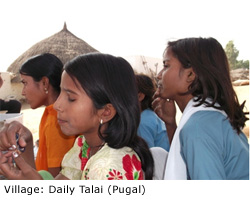
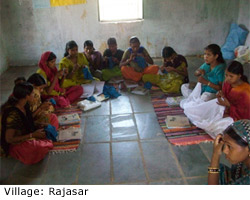

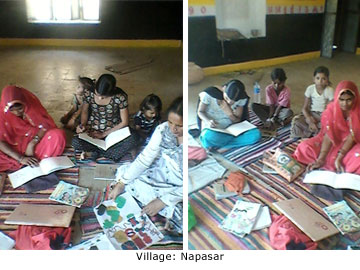 Work done by Students:
Work done by Students:
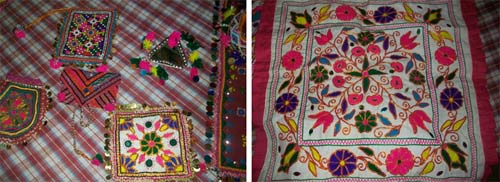
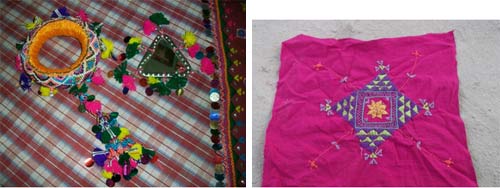
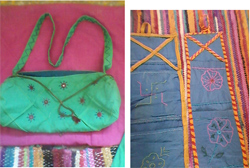 Teacher Training in Bikaner:
(Conducted by Babita – Rangshiksha team, Ruchi Tripathi – Rangsutra’s Designer, Sujit Jha – Rangsutra team, Megha Agarawal – Project Consultant)
Teacher Training in Bikaner:
(Conducted by Babita – Rangshiksha team, Ruchi Tripathi – Rangsutra’s Designer, Sujit Jha – Rangsutra team, Megha Agarawal – Project Consultant)
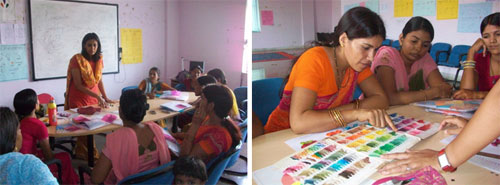
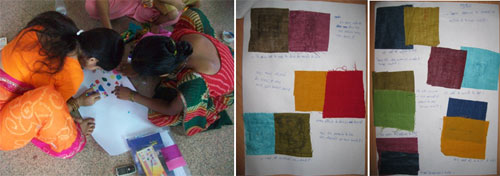
 References
[KVIC], K. a. (2010). Khadi and Village Industries Commission [KVIC]. Khadi and Village Industries Commission [KVIC] .
Aiaca. (2008, September). Case Study: Rangsutra- producer vs. private limited company. (2008-09). Annual Report. Kala Raksha. (2010). Annual Report. Ministry of Textile.
Anxo Cereijo Roibás, N. S. Travelling Stories: Mobile Applications for Storytellers. SCMIS,University of Brighton (UK), National Institute of Design (India), Dare (UK).
Cabrera V, P. (2.2007). Reflections on design for competitive artisan communities —Towards an approach for the sustainability of local cultures. Artelogi 10 - Käsiteollisuuden Tutkimusseura Ry., Finland.
CCI. (2010). Co-Creating, Designers Meet Artisans: Guidelines to interaction.
Chandra, S. Gendering English: Sexuality, Gender and the Language of Desire in Western India. 2007.
Chatterjee, A. (n.d.). The Indian Craft: Sunrise or Sunset in a Global Market. Craft Revival Trust. College, B. (2008-09). Annual report. Tilonia.
Collins English Dictionary - Complete and Unabridged. (2003). HarperCollins Publishers. (2005-06). Diagonostic study of Kota.
Dr. Daljeet, D. V. Gallery Sheets of Indian Miniature paintings. New Delhi: National Museum.
Frater, J. (2009). Annual report. Bhuj.
Gandhi, M. Harijan.
Gollancz. (1940). India Today. London: British book publishing house.
Kak, D. K. (2002, November 16-18). Integrating Crafts and The Education System. New Delhi, Delhi, India.
Kasturi, P. B. (n.d.). Transforming the 'Guru-Shishya' Parampara: Changing the way training is planned in craft sector. Ahmedabad, Gujrat, India: NID.
Kramrisch, S. (1956). Artist, Patron, and Public in India.
(2010). KVIC Annual report. KVIC.
Levkovsky, A. (1966). Capitalism in India: Basic Trends in Development. Bombay: People's Publishing House.
Lodaya, A. (n.d.). The Crisis of Traditional Crafts in India. India: Craft Revival Trust. Page 14 © Megha Agarawal
Mathur, N. (2006, August 5). REHWA: Maheshwari Handloom Weavers. Economic and Plolitical Weekly .
Mayoux, L. (2003, September 30). Alternative vision or Utopian fantasy?: Cooperation, empowerment and women's cooperative development in India. PortSudan .
(2010). Mid term evaluation of 11th 5 year plan - handloom. Delhi: NIC.
Nehru, J. L. (1946). The Discovery of India. Penguin Books India Pvt. Ltd.
Plowright, P. S. (2005). The Desacralization of Puppetry: a Case History from Rajasthan. New Theatre Quarterly , 21, pp 273-298 doi:10.1017/S0266464X05000163.
Pollanen, S. (2009). Contextualizing Craft: Pedagogical Models for Craft Education. The Author Journal Compilation .
Prasad, D. (2005). Maintenance of Traditional Occupation: A Case from the Telugu. J. Soc. Sci., 11(2): 141-149 .
Ramakrishnan, K. (1999, March 21 Sunday). An umbrella for craftsmen. Special issue with the Sunday Magazine - The Hindu .
Ramaswamy, V. (2004). Vishwakarma Craftsmen in Early Medival Peninsular India. BRILL. (1950). Report. Radhakrishnan Commission.
Roy, M. L. (2004). Handmade in India: Traditional Craft Skills in a Changing World. World Bank.
SEWA Website. (2011, July 30).
Spodek, H. (1994). Review: The Self-Employed Women's Association (SEWA) in India: Feminist, Gandhian Power in Development. Temple University.
UNIDO. (2002). Case Study: Cluster Intervention in Kota. Kota: UNIDO.
Venkatesan, S. (2009). Rethinking agency: persons and things in the heterotopia of 'traditional Indian craft'. Journal of the Royal Anthropological Institute 15, no. 1 .
References
[KVIC], K. a. (2010). Khadi and Village Industries Commission [KVIC]. Khadi and Village Industries Commission [KVIC] .
Aiaca. (2008, September). Case Study: Rangsutra- producer vs. private limited company. (2008-09). Annual Report. Kala Raksha. (2010). Annual Report. Ministry of Textile.
Anxo Cereijo Roibás, N. S. Travelling Stories: Mobile Applications for Storytellers. SCMIS,University of Brighton (UK), National Institute of Design (India), Dare (UK).
Cabrera V, P. (2.2007). Reflections on design for competitive artisan communities —Towards an approach for the sustainability of local cultures. Artelogi 10 - Käsiteollisuuden Tutkimusseura Ry., Finland.
CCI. (2010). Co-Creating, Designers Meet Artisans: Guidelines to interaction.
Chandra, S. Gendering English: Sexuality, Gender and the Language of Desire in Western India. 2007.
Chatterjee, A. (n.d.). The Indian Craft: Sunrise or Sunset in a Global Market. Craft Revival Trust. College, B. (2008-09). Annual report. Tilonia.
Collins English Dictionary - Complete and Unabridged. (2003). HarperCollins Publishers. (2005-06). Diagonostic study of Kota.
Dr. Daljeet, D. V. Gallery Sheets of Indian Miniature paintings. New Delhi: National Museum.
Frater, J. (2009). Annual report. Bhuj.
Gandhi, M. Harijan.
Gollancz. (1940). India Today. London: British book publishing house.
Kak, D. K. (2002, November 16-18). Integrating Crafts and The Education System. New Delhi, Delhi, India.
Kasturi, P. B. (n.d.). Transforming the 'Guru-Shishya' Parampara: Changing the way training is planned in craft sector. Ahmedabad, Gujrat, India: NID.
Kramrisch, S. (1956). Artist, Patron, and Public in India.
(2010). KVIC Annual report. KVIC.
Levkovsky, A. (1966). Capitalism in India: Basic Trends in Development. Bombay: People's Publishing House.
Lodaya, A. (n.d.). The Crisis of Traditional Crafts in India. India: Craft Revival Trust. Page 14 © Megha Agarawal
Mathur, N. (2006, August 5). REHWA: Maheshwari Handloom Weavers. Economic and Plolitical Weekly .
Mayoux, L. (2003, September 30). Alternative vision or Utopian fantasy?: Cooperation, empowerment and women's cooperative development in India. PortSudan .
(2010). Mid term evaluation of 11th 5 year plan - handloom. Delhi: NIC.
Nehru, J. L. (1946). The Discovery of India. Penguin Books India Pvt. Ltd.
Plowright, P. S. (2005). The Desacralization of Puppetry: a Case History from Rajasthan. New Theatre Quarterly , 21, pp 273-298 doi:10.1017/S0266464X05000163.
Pollanen, S. (2009). Contextualizing Craft: Pedagogical Models for Craft Education. The Author Journal Compilation .
Prasad, D. (2005). Maintenance of Traditional Occupation: A Case from the Telugu. J. Soc. Sci., 11(2): 141-149 .
Ramakrishnan, K. (1999, March 21 Sunday). An umbrella for craftsmen. Special issue with the Sunday Magazine - The Hindu .
Ramaswamy, V. (2004). Vishwakarma Craftsmen in Early Medival Peninsular India. BRILL. (1950). Report. Radhakrishnan Commission.
Roy, M. L. (2004). Handmade in India: Traditional Craft Skills in a Changing World. World Bank.
SEWA Website. (2011, July 30).
Spodek, H. (1994). Review: The Self-Employed Women's Association (SEWA) in India: Feminist, Gandhian Power in Development. Temple University.
UNIDO. (2002). Case Study: Cluster Intervention in Kota. Kota: UNIDO.
Venkatesan, S. (2009). Rethinking agency: persons and things in the heterotopia of 'traditional Indian craft'. Journal of the Royal Anthropological Institute 15, no. 1 .
End Notes
- Lodaya, Arvind.(n.d.) The crisis of traditional crafts in India, Craft Revival Trust
- Frater, Judy. (e.d.) Kala Raksha Vidyalaya: An Institute of Design for Traditional Artisans, Craft Revival Trust
- Pollanen, Sinikka. 2009 Contextualising Craft: Pedagogical Models for Craft Education, The Author Journal Compilation. NSEAD/Blackwell Publishing Ltd.
- National Institute of Design, Ahmedabad
- 31 Dec 2001, National Institute of Design, Ahmedabad
- Patel, Usha Nehru. April 2010 A Directional Study Towards Empowerment: Finding a New Horizon, Craft Revival Trust
- Case study from Draft of: Co-creating, Designers Meet Artisans: Guidelines to Interaction, Craft Revival Trust
- Case study from Draft of: Co-creating, Designers Meet Artisans: Guidelines to Interaction, Craft Revival Trust
- Bhatt, Jatin. Oct-Nov 2008. Innovating New Paradigms of Value in Handicrafts, Craft Revival Trust
- Annual Report. 2009 Kala Raksha Vidyalaya, Bhatt, Jatin. Innovating New Paradigms of Value in Handicrafts. Nov 2008, Craft Revival Trust
- Gose, Sumita. May 2010. Brief for Rangshiksha Schools, Rangsutra India Pvt. Ltd.
- Murray, Kelvin. March 2008. What Price Culture? A Hypothetical about Craft and Design. Craft Revival Trust

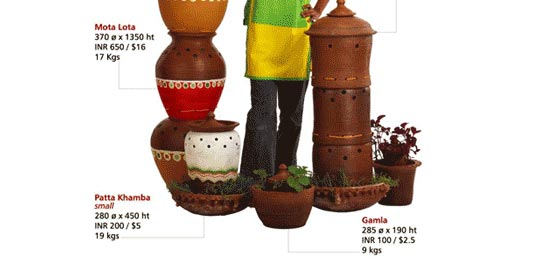 |
Distribution: Where the product is currently available
The product is currently available in Bangalore city, India
What is it? Explain in non-technical terms the purpose of the project, the intended user and how it is to be used.Bangalore – a dump?
Bangalore produces 2000 tonnes of wastes everyday. The centralized government composting plant can handle only 500 tonnes per day. The rest reaches dumps that are illegal. Till Bangalore gets a planned and efficient waste management programme, this situation is likely to continue. And the planned programme is nowhere in sight.
The story today
70% of the waste generated in the average Indian urban home is organic wet waste. Bangalore had large houses with gardens and people composted in pits in their backyards. Now, they just throw the waste out onto the pile at the end of the road. The government tried to introduce a “Swacha Bangalore” campaign of collecting segregated waste at the doorstep. Our research revealed that citizens lost faith in this system once they saw that segregated waste is missed up again in the truck that transports the waste to the landfill site.
Home composting – is it possible?
We asked Bangalore homemakers about home composting. Here’s what we found:
|
 |
So a mere product range was not the solution. This project is about the design of an overall system that would deal with products, communication, service and dissemination – using lessons from eco-sustainability. |
 |
|
To have very visual material, that is easy to understand by our target customers and also try and make it available in different Indian languages
|
Research: Describe the scope and constraints of the effort. What was innovative or unique about the methods used and their integration with the development process?
|
 |
|
|
Books & Articles
|
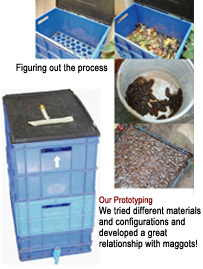 |
 |
|
What was the design solution and how is it environmentally innovative?
The solution we designed is a brand and product + service bundle.
The product is basically a terracotta container (or ‘pot’), which comes in a range of sizes and forms. The containers are designed to allow for aeration which is critical for composting. The design helps rotate and distribute volumes which makes composting at home managable. The user (i.e. the Indian homemaker) dumps the day’s organic waste into the containers, and has to attend to maintenance only once a week. The containers are modular so easy to replace if damaged. The products require less space than traditional compost pits. They are cheap and easily affordable, very easy to use and maintain, and of a form that Indians can relate to culturally.
The service component involves helping the user with the minimal maintenance that is required – i.e. help with managing files and other pests, and rotating the pile of waste as necessary.
Some of the significant aspects of this solution are listed below.
|
Eco Assessment: What processes, methods were used in your assessment?
|
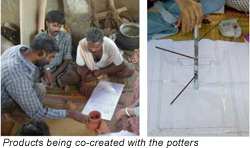 |
Materials and production: How is it made and what materials are used.
Terracotta is the primary material for the products. The reasons for this decision are:
|
|
 |
|
Aesthetics: How does the appearance enhance the product and encourage acceptance?
The appearance of the product achieves several things:
|
|
| Business: How did the design improve the clients business? (Such as cost, profits, regulatory compliance, liability reduction, waste/ energy/toxin reduction, worker benefits, eco-recognition/certification, market penetration, higher value/ perceived quality, documented customer satisfaction, brand elevation, new opportunities etc.)“Daily Dump” the brand we created for the client, has just launched commercial operations – so the impact of the design on the business is yet to be fully realised.As of now, however, the client’s business has benefited in the following tangible ways: | |
|
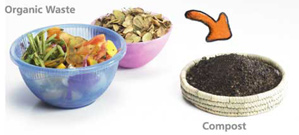 |
|
|
Armies of the Rajputs, Mughals and Tipu Sultan were renowned for their weapons. Every state had its own forging unit and the metals were locally procured and crafted. Not only where they the sharpest and strongest but each was a work of art, carved and bejeweled. The range and magnificence of the arms found in India was astounding as can be seen from the extensive visual documentation available. Any miniature painting of any tradition which has a male as its subject shows him in full armored finery. It was an art form held in the highest esteem, a honed science which, with the right combination of heat, metal and forging created arms to suit the physiognomy of the soldier.


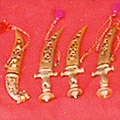
In the kaarkhanas or workshops in Udaipurin the Mewar region of Rajasthan a unique and unusual form of glittering ornamentation called Danke-ka-Kaam is embroidered on to textiles. Danka are small gold and silver square metal faceted discs, not larger than 1.5 centimeters that have been hand-beaten to form a facet that glints and reflects light akin to a diamond. Stencils are used to transfer the motifs including paisleys, flora, peacocks, betel leaves, vines, geometrics and scrolls as metallic zari yarns are worked in the zardozi technique around the faceted danka couched on to sumptuous and brightly colouredsilks, satins and velvet with the help of several needles, from sewing needles to the hooked needle locally known as ari. The danka lies at the heart of the opulent embroidered ceremonial poshaksworn by Mewari Rajput women at weddings and festive rituals. This traditional garment comprises of a kanchali (blouse) ghagara (full length) gathered skirt and odhna (head) mantle. In the last few decades danka has also been embroidered onto saris and other garments. Danke-ka-Kaam remains relatively unknown outside its own geography. The Danka kaarkhanas are mainly located in the colloquially named Boharwadi or colony of the Bohras where the making of the danka pieces and its embroidery are practiced by the small Bohra Muslim community who migrated to this area in the 16th century and continue their traditional practice today. SaifuddinZariwala is the senior most of the practitioners. Now in his 70’s he is the seventh generation of his family practicing the craft. Whereas, Kaizer Ali Motiwala who learnt the craft from his father lives and works in the BadaBaazar area and is a fifth generation practitioner of the craft. While a little over 25karigarsengaged in danka embroidery, the sole custodian of the skill today lies withBabuBhaiQutubudinZariwala who has passed on the family tradition to his daughter SidhikaBanu. It is in their karkhaana where the danka is meticulously crafted. The women of the Bohra community help with the winding of the kasab, the metallic yarn used in the embroidery. Additionally, the women are also engaged in the make of fine lace with silver and gold kasab, however, the same remains largely uncommercialized and is done for personal use. This craft is said to be known and practiced by all the Bohra women in Rajasthan and is considered as essential a skill as knowing how to cook. Included in the list of languishing crafts, the skill and the making process remains undocumented and thus solely relies on oral traditions. Danke-ka-Kaamlies waiting to be discovered to be given a new lease of life. [gallery ids="165418,165419,165420,165421,165422,165423,165424,165425,165426"] First published in the Sunday Herald.
Dasavatara, (Das=ten and avatara =incarnation or descent) of Lord Visnu, is the most popular concept of Hinduism, which has been widely worshipped by the Hindus in one or the other form.' Stone, bronze, terracotta, painting on pata (cloth), a wood were the most accepted material on which a number of images of Visnu were made.' Apart from these materials, ivory was also used for making the image of a deity. The earliest reference of deity made from ivory is of seated Buddha from Kashmir region, which belongs to eighth-ninth century A.D.' From seventeenth century onwards several images of gods-goddesses were made in ivory and National Museum at New Delhi has a good collection of such images.'' Among the various gods-goddesses images, the most attractive images are the Dasavatara of Lord Visnu, which has been intricately carved on three objects. First, is the most attractive example of a small home shrine, second is a box and third is the manuscript cover. Small and beautiful, all these ivory objects have been carved with high quality of aesthetics, in the most outstanding manner. The focus of this paper is twofold; first to look at the aesthetic qualities of Dasavatara images of the National Museum collection and second aspect is to examine as to why these objects were made. Especially when, the ivory being a bone medium, is forbidding for worship. Before discussing any further, I would like to discuss the three objects illustrating Dasavatara images.
STEPPED HOME SHRINE
Magnificently carved, this small ivory shrine depicts the most popular ten incarnations of Lord Visnu's images (fig. 1). All the images are carved in round and beautifully arranged on a stepped base, which is made of sandalwood, but figures are made of ivory. Four armed image of Matysa (fish) avatara has been placed on the topmost step and the very next step of the shrine depicts two avataras; Kurma (tortoise), Vardha (boar). The third step illustrates the images of Narasimha (man-lion), Vamana and Paragurama, while images of Rama, Balarama, Krsna and Kalki incarnations are fixed on the foremost frontal step. All the images are in standing posture and stands on double lotus oblong shaped base. Matysa, Kurma, Varaha, Narasimha and Kalki images are four armed, which conveys the idea of the God's supremacy. All of them hold larikha, cakra in their two hands, while the other two hands are in abhaya and varada mudra except Kalki incarnation, which holds a sword and a shield. Remaining images; Vamana, Parasurama, Rama, Balarama and Krsna are two armed and hold different attributes. Vamana holds umbrella and water vessel while Parasurama carries axe and bow. Rama holds bow and arrow and Balarama is carrying the mace while the other hand is in abhayamudra. Krsna is carrying the stick/flute and sankha in his two hands. All the incarnations wore dhoti as a lower garment and are adorned with jewellery like; necklace, bangles, armlet and kiritamukuta (crown) except Vamana, who is without crown. Carved in round, all the images illustrate the intricate details with prefect body proportion and great aesthetic qualities. The sandal-wood base of the shrine is fully covered with ivory sheet and backdrop of the shrine is decorated with perforated ivory screen. Jalidar (lattice work) screen is divided in three parts by the European style pillar. Shades of black on the base of the ivory shrine look beautiful because of the jail work of the screens. Stylized full-blown flower pattern on top of the screen adds charm to the object. An ivory strip on the wooden edges of the steps and base of the shrill depicts the foliage pattern. The pillars at the back and tiny knobs on the edge of shrine make I attractive and complete. In Trivandrum, south India, artists were the specialists of making such images.' The screen and the base of shrine are decorated with black paint and this reminds the craftsmanship of Mysore artist.6 The delicate plain images carved in round appears to be from Trivandrum, which have been fixed on painted base in the backdrop of screen providing a beautiful example of Mysore school of ivory painting of south Indian tradition. The intricate carving with great art and aesthetic places this piece to the period of late eighteenth or early nineteenth century A.D.BOX FOR KEEPING RELIGIOUS OBJECTS
Small rectangular ivory box depicts Dasavatara images of Lord Visnu on the sidewalls pa of the box an Dravidian style temple architecture is on the lid's inner portion (fig. 2). Remaining portion of the box is plain such as; upper portion of the lid, walls of inner portion and base of the box. Three out of four sidewall panels illustrates ten incarnations of Visnu, which have been worked in small compartments like arrangement. Each compartment is divided through pillar and has arched decoration on the upper portion of the compartment. The front wall panel depicts four incarnations, arranged clockwise, Matsya, Kt-Irma, Varaha and Narasititha. Next side panel illustrates Vamana, Parasurama and Rama incarnations and the fourth side panel illustrates the three forms of Visnu; Balarama, Krsna and Kalki avatara. All the incarnations are in standing re and are carved in low relief. The third wall panel of the box, which is at the back, depicts the elaborate Rama Darbara scene. Rama-Sita is sitting on throne in the center with his brothers and the Hanuman standing on the right side, while saints are sitting on their thrones on the left. The inner portion of box's lid portrays Dravidian style temple architecture. The innermost portion of the temple depicts two images of Lord Visnu. In the first, he is reclining on Sesanaga in the other form. He is in standing posture and flanked by Bhu Devi and Sri Devi. Door guardians Jaya-Vijaya are standing on either side of the entrance gate. Small Devi shrines are ar the entrance and around the main shrine. Depiction of Garuda, saints, Devis are in small compartments, which have been arranged vertically on both sides. All the incarnation images have been carved in relief and to highlight the figurative aspect the images more boldly; artist has painted the images with light green colour. To give the three mensional effect artists has used the red and black colours on the background of the images, ich adds attraction to object. This appears to be the workmanship of Mysore artists of early nineteenth century.MANUSCRIPT COVER
The manuscript cover in two parts has been carved with Dasavatara images on the reverse side while; obverse side illustrates the floral design (fig. 3). Each cover illustrates the five incarnations, which have been carved in compartments under a niche. The front side of both the manuscript covers depicts bold floral creeper and foliage of flower and leaf along with full-blown lotus motif in the center, which is having hole to thread the manuscript. One side of the cover depicts the God's first five forms, which are: Matysa (fish), Kurma (tortoise), Varaha (boar), Narasimha .(man-lion) and Vamana (dwarf). All the images are crowned and four-armed; in two of the hands they hold sankha and cakra, while other two hands are in varada and abhaya mudra. Similarly, the other panel illustrates the next five forms of Visnu, which are: Parasurarna, Rama, Balarama, Krsna in the form of Jagannatha and Kalki incarnations. All the incarnation icons carved in low relief, but the images are showing a lot of power, energy and every one on the move. The small manuscript cover follows the proper sequence of incarnations. Krsna's Jagannatha's depiction as well as workmanship of this object appears to be done by the Orissan artisans of nineteenth century.RELIGIOUS TEXTS NARRATION REGARDING MATERIAL FOR IMAGE
In all the three objects, artist has carefully followed the iconography of Visnu and a proper sequence of His incarnations, as mentioned in the ancient texts. No doubt these are great work of art, but the question is why these images were made? Whether, these are made for worship or these are made just for decorative purpose? When seen under the light of religious sensitivity of Hindus, they never recommend for making the deity's ivory images. Worship of deity's personified form or icon started somewhere in first century A.D.' Before that, man use to worship the nature. Then, early Vedic Aryans' religious life revolved round the glorification in prayer and yajna.8 Gradually, image worship became the popular religious and philosophical solution to overcome from the difficulties faced by the human being. Its practicality made the thinkers to find out the suitable material, the appropriate tala-mana (dimension and iconometry) of the icon making. And then a detailed description was made regarding the iconography of deity, size, proportion of body, `ayudha' which they use to hold, their dress, ornaments, seat, etc. Several texts were written which talked about almost the whole aspects related to iconometry. The important ones are Agama literature9', Puranas10, Samarangana Sutradhara11, Aparajita Prccha12, Rupamandana 13, Visnudharmottara14, etc. The icon planning is not a ritual but also a scientific pre-requisite. Any planning, if it is scientific must start with correct proportions as laid down in the sastras, before fashioning an image out. These texts talk about the materials as well, in which the deity has to be made. Many of the Vastu Sastra texts mention the type of materials from which an image of a deity can be made, which are six,15 seven,16 eight17 or nine18 in number. Even Samarangana Sutradhara goes further when it says that by making deity's image in different materials and worshipping it, the gain of a devotee is different, which says:19 Icon made of The rewards gained Gold Health Silver Fame Copper Progeny Stone Landed property and victory Wood Longevity Lekhya Wealth Lepya Wealth Ivory as a medium for making deity's icon was not mentioned in most of the iconography texts except one reference, which is in the Agama literature. According to Agama literature, six varieties of materials are recommended for making the images of deities which are; wood, stone, precious gems, metals, earth and also a combination of two or more of the aforesaid.20 Another authority mentions three more mediums, besides six, which are brick, kadi-sarkara (a preparation the chief ingredient of which is the limestone) and danta (ivory).21 From seventeenth century onwards, a lot of images of God and Goddess were made in ivory. This was the phase when a lot of Christian images were made in ivory under the influence of Europeansn22, who came in India for trade, but also brought their religion. Picking the ivory artwork as souvenire by the European official at the time of return to their country land after finishing their duty in India also encouraged the ivory carvers to experiment new subject and variety of objects.23 Probably all these circumstances became the reason for the use of ivory for making the Hindu God and Goddess images. Bengal, Orissa, Mysore, Trivandrum became the center for making the deity's image in ivory during this phase. Stepped home shrine, small box for keeping religious things and manuscript cover, all these are objects appear to be made in Mysore centre and of date late eighteenth and early nineteenth centuries. It is not very certain the use of such images however one cannot deny the decorative use of such images of if at all these were used for worship then only within the home shrine. This reminds of the Bengal's tradition of making Durga images and some ivory Durga images, perhaps carved for home shrines during the nineteenth century have survived in the collection of museums.24 In the end, one can say that whatever may be the use, aesthetic quality of such images is highly appreciated, which everyone should enjoy.
Figure1: Ten incarnation of Visnu

Figure2: Dasavatara images of Visnu on side wallspanels of the ivory box

Figure3: Reverse side of the ivory manuscript cover (courtesy: National Museum New Delhi)
References The early references of ten incarnations of Visnu are found in .Satapatha Brahmana and Taittiriya Samhita. Details are in T.A.G. Rao, Elements of Hindu Iconography, I, pt. I, pp. 119-223, Delhi, reprint 1993; K.S. Desai, Iconography of Visnu, Delhi, 1973, pp. 62-41; N.P. Joshi, Prachin Bharatiya Murtivigyani, Patna, 2000, pp. 97-105. Khajuraho temples depict number of Dasavatara images in stone. See K.M. Suresh, Iconography of Visnu from Khajuraho, Delhi, 1999, pl. 16-17, pp. 33-74; Large scale metal Vaisnava avatara frame from Devsar published by P. Pal, The Arts of Kashmir, Asia Society, fig. 47, 2007, p. 65; Jor Mandir group of temples, Bishnupur, depicts incarnations of Visnu images in terracotta published by A.K. Bhattacharya, Bishnupur Land of wrestlers, in P. Pal (ed.), Marg, Mumbai, 2003, pl. 9, p. 107; Dasavatara figures are painted on the pata published by J.P. Das, Puri Paintings, Delhi, 1982, pp. 58-59. National Museum has wood carving panel depicting Dasavatara images from Tamil Nadu. P. Dwivedi, Indian Ivories through the Ages, Delhi, 1976, pp. 101-105. Gansa- pl. 2; Visnu Sesasayi- pl. 3; Krsna- pl. 4; Radha- pl. 15; Krsna- pl. 14, published by K. Lai, Indian Decorative Arts, exhibition catalogue, Dresden, Germany, 1984; Dwivedi, op. cit., p. 134. A similar type of images has published by T.A. Gopinath, cit., p. 123, pl. xxxv. K. Pal and B.K. Roy, Ivory Works in India through the Ages, Census of India 1961, Delhi, 1967, 1r vol. 1, pt. VII-A, p. 109; Dwivedi, op. cit., pp. 128-129. N. Banerjee, Development of Hindu Iconography, Calcutta, 1956; G. Michell, Introduction to Indian Sculpture, In the Image of Man, U.K., 1982, p. 14. N. Shukla, Vastu Sastara, vol. II, Gorakhpur, 1958, p. 27. Tala mana is Agama literature's chief contribution to the canons of iconometry, D.N. Shukla, , p. 55. Matysa Purana mentions silver, copper, precious stones, wood, iron, lead, stone, brass and pp mixture of two or more metal. Bhavisya Purana refers glass, silver, copper, stone, wood and painting, published by B. Malviya, in Visnudharmottara mei Murtikala, Prayag, 1960, pp. 108, 109. Samarangana Sutradhara written by king Bhoja, who was the king of Dhar. He ruled Malwa around 11th century. Author provides the all information about architecture and iconography, D.N. Shukla, cit., p. 55. Aparajitaprccha is written by Bhuvandeva, which provides more information about the Dravidian architecture and its iconometry. D.N. Shukla, cit., pp. 55-56. Rupamandana is a post Samarangana and mirrors some of the later phases of development of Hindu Iconography, D.N. Shukla, cit., p. 70. Malviya, op. cit., pp. 108-09. Agama literature, Rao, cit., p. 48. Samarangana Sutradhara, p. 94, and Bhavisya Purana, 108. Sukranitisara, Malviya, cit., p. 108. Matysa Purana, Malviya, cit., p. 109. N. Shukla, op. cit., p. 94. Rao, cit., p. 48. Rao, cit., p. 49. Desai and Gorakshkar, Images of Christianity, Ivory and wood icons from Goa, The India Magazine, June, 1985, pp. 40-47. Archer, Company Paintings, London, 1992, pp. 225-26. Dwivedi, cit., p. 133; M.K. Pal and B.K. Roy, op. cit., 1967, p. 107





